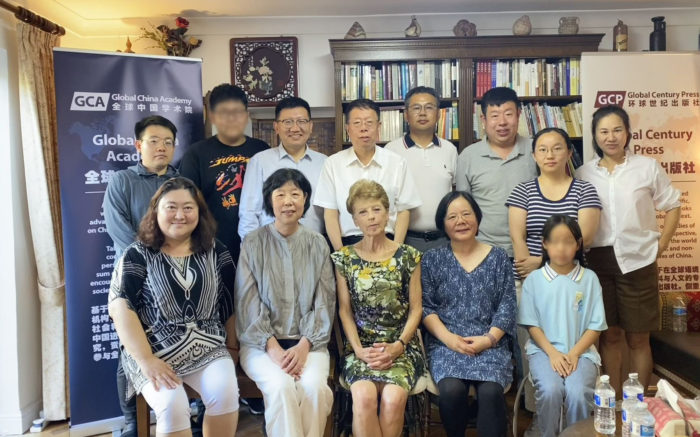
GCA Life Fellow Professor ZHU Guanglei and His Family’s Visit to the UK (2-11 August 2024)
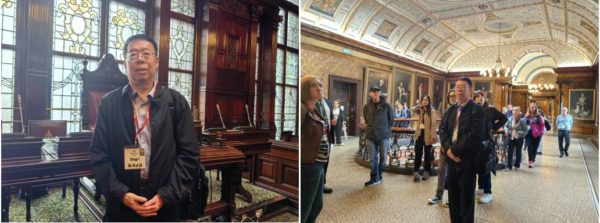
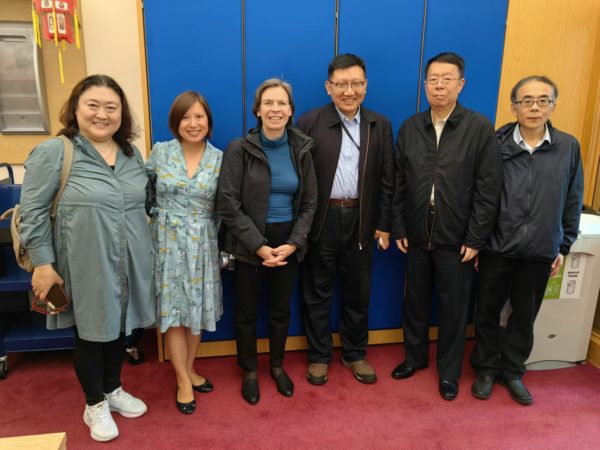
Around 7 pm. on August 8, I visited the hotel where Professor Zhu and his family were staying in Willesden Green to welcome them. Thanks to Professor Zhu’s thoughtfulness, the postcode is NW2, just a 20-minute drive from the GCA Fellows’ Home (NW7). In a city as vast as London, you could almost call us neighbours! Inspired by the traditional Chinese intellectual ideal of ‘reading ten thousand books and traveling ten thousand miles,’ I added two more phrases: ‘dining on international cuisine and making friends from all corners of the world.’ I chose a nearby Turkish restaurant, Lezziz Charcoal Grill, to host them. The restaurant has a simple yet warm decor and offers authentic Turkish kebabs and a variety of Mediterranean dishes. The top left photo shows our ‘big family photo’ (from left to right): Professor Zhu’s son, daughter-in-law, wife, granddaughter, Professor Zhu himself, and me. After enjoying a rich Mediterranean salad, the barbecue feast that followed was about twice the size of what’s shown in the bottom left photo, and the desserts and tea that came afterward were also quite special.
During the meal, we discussed the differences between Chinese and Turkish cuisine, from their forms to their content, and appreciated their attitude of ‘admiring the beauty of others’ and ‘harmony in diversity’ (Fei Xiaotong’s term). Professor Zhu mentioned that restaurants in the UK are livelier than those in China. However, on the way back after dinner, I noticed that quite a few restaurants were rather quiet, which suggests that my choice was not bad, and everyone seemed quite satisfied. I believe that time abroad is precious, and aside from clothing, the experiences of food, accommodation, and travel should all differ from those in our home country.

From August 9 to 10, accompanied by friends and the Academy’s Operations Manager, David Liu, Professor Zhu and his family visited various attractions in London and the surrounding areas.
On the afternoon of the 10th, Professor Zhu and his family came to GCA Fellows’ Home, where they received a warm welcome. The following photos, from left to right and top to bottom, show: me giving a brief introduction to the day’s activities; Professor Zhu presenting a gift to the Academy. He explained that it is a ‘Lotus and Surplus’ New Year painting from Yangliuqing, Tianjin [Note 2], and he wished it would bring good fortune to the Global China Academy. Following this, Professor ZHAO Kejin presented small gifts to both me and Ingrid Cranfield, the former chair of the Academy’s Board of Trustees and the president of Global Century Press.
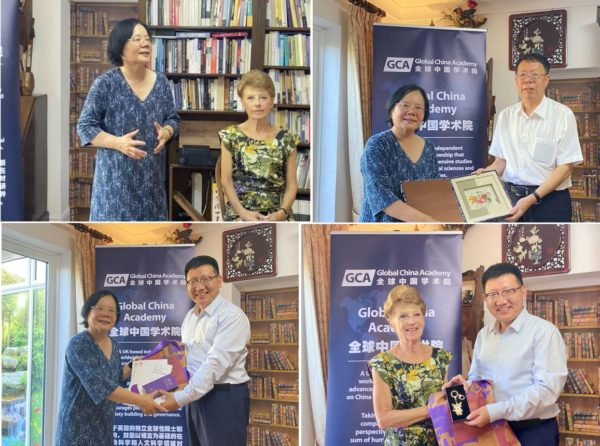
The following is an expanded ‘big family photo,’ which includes three generations of Professor Zhu’s family (five members) and a friend, Professor Zhao’s family of three, and four staff members from the Academy. In addition to Ingrid and me, the photo also includes Operations Manager David Liu (fourth from the right in the back row) and Project Manager Li Yu (first on the right in the back row). I appreciate both of them for driving and accompanying the two families on visits to Oxford and other places respectively.
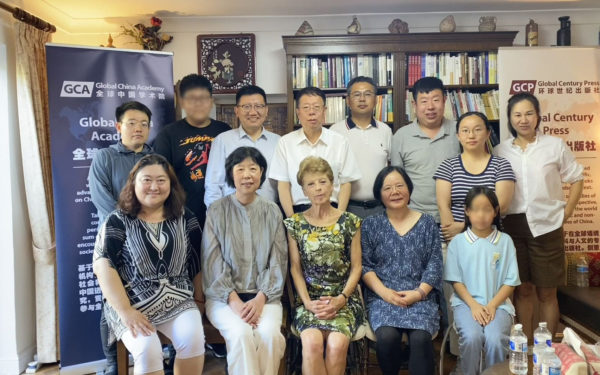
Next is free discussion time (see photos below).

The dinner was a Western-style meal, held in two separate dining rooms: 10 people in the main dining room, and Professor Zhu’s son and his family of three in the garden dining room (as shown in the top left and right of the photos below). It was only afterward that we realized the three courses represented a combination of Italian, French, and British flavors.
- The starter consisted of two parts: one part was a Mediterranean-style seasoned avocado, where the avocado was halved and pitted, then drizzled with balsamic vinegar and olive oil, and sprinkled with black pepper. This dish highlighted the creamy texture of the avocado and its subtle nutty flavour, while the tanginess of the balsamic vinegar and the fruitiness of the olive oil added layers of complexity. The other part of the starter was a beetroot salad with basil and cashews, made with beets handpicked from a nearby farm, boiled, and then mixed with fresh basil leaves and cashews, all tossed in olive oil to create a refreshing salad with a hint of nutty flavour.
- The main course: Since Professor Zhu mentioned he wanted to have grilled fish, we prepared gratinéed salmon with samphire, buttered potatoes, and purple sprouting broccoli. This dish incorporated many classic elements of French cuisine and can thus be classified as a French-inspired dish.
- Dessert: Apple and blackberry pie with cream, all homemade by Ingrid. This is a classic British dessert, combining the sweetness of apples with the slight tartness of blackberries. The pie had a crispy crust and a juicy filling, complemented by smooth, rich homemade white cream. The white of the cream contrasted beautifully with the golden pie crust and the deep red-purple of the fruit filling, enhancing the overall dining experience. The combination of the creamy milk flavour and the fruity aroma of the pie created a striking taste contrast, offering a very comforting culinary experience. [Note 3]
Most importantly, every apple and blackberry used to make these two pies was handpicked by Ingrid herself. We hope that our Fellows and their families can truly feel at home at the GCA Fellows’ Home and take away fond memories of familial warmth.
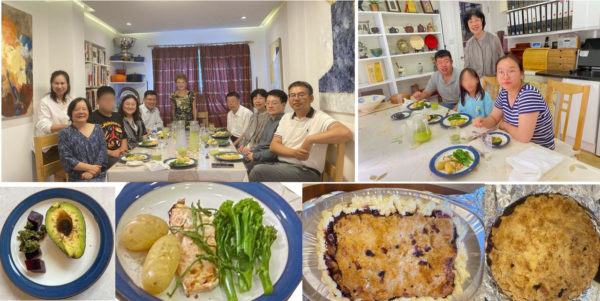
After dinner, having coffee and tea—a dining habit that combines elements of health, tradition, culture, and social interaction—added much enjoyment and benefit to the evening. The following photos show scenes of everyone chatting and drinking from the dining room to the garden, with everyone leaving fully satisfied.
The photo on the bottom right was taken the next morning when I went to Professor Zhu’s residence to bid farewell to his family. When asked if he felt homesick after coming to the UK, he replied, ‘My whole family is here, and we’ve enjoyed the home-like hospitality at the Fellows’ Home, so of course, I’ll miss this home!’ As I watched the minibus take Professor Zhu and his family to the airport, I felt a deep sense of admiration for the seamless coordination among our colleagues and team during this first-time reception of a Fellow and his family at our Fellows’ Home.


- In 2018, during the preparations for the Fifth Global China Dialogue: Global Governance for Justice, we invited Professor Zhu Guanglei, Vice President of Nankai University, as the keynote speaker from China. Since he was initially introduced as ‘President Zhu,’ we have continued to use this title thereafter in Chinese version.
- This is a New Year painting from Yangliuqing, Tianjin, a famous form of Chinese folk art that originated in the Ming Dynasty. The lotus in the painting symbolizes purity and nobility, the child represents innocence and hope, and the carp signifies good fortune and abundance. The painting is titled ‘Lotus Year with Surplus,’ which is a play on words, as the phrase sounds like ‘abundance year after year’ in Chinese.
- The detailed description of the dinner here might be unnecessary for English readers. However, the following examples encouraged me to write freely on the blog.
- I recall our English editor suggested cutting out the part about ordering and discussing the meal at ‘The Real Greek’ restaurant in the blog post on ‘Global China Academy’s Two-Day Team Building: Integrating Academic Insights with Cultural, Historical, and Natural Exploration,’ because it might seem “boring” to British readers.
- This reminded me of a book published by Global Century Press titled Cultural Gap—Notes of a British Broadcaster Growing Up in China, written by Paul Crook and published in 2017. It’s a Chinese book, and he believed it shouldn’t be translated into English because it would likely seem “boring” to British readers. I accepted his judgment, as he grew up in a bilingual environment of both English and Chinese. Paul’s father, David Crook (1910-2000), was a British communist, writer, and teacher, and his mother, Isabel Crook (1915-2023), was a British-Canadian social anthropologist, professor, and educator. They co-authored several books, including Revolution in a Chinese Village, Ten Mile Inn (1959) and Ten Mile Inn: Mass Movement in a Chinese Village (New York: Pantheon Books, 1979). Since 1949, they had been teaching English at Beijing Foreign Studies University.
- Another example is when our graphic designer added a note in the ‘GCP style rules for rendering Chinese-English dual languages’ (3.1.2 GCP style rules for rendering Chinese-English dual languages) section of the Global Century Press House Style Guide: ‘Note for English-language readers: The following two sections (3.1.2 and 3.1.3) are not relevant. They contain information mostly relating to the typesetting of GCP’s overseas Chinese editions – the transcultural process of combining English and Chinese typesetting styles for overseas Chinese readers.’ (p. 26). I borrowed this note as an explanation for all my blog readers, whether they are English or Chinese speakers.
Chang Xiangqun, August 22, 2024

全球中国学术院终身院士朱光磊教授携全家访问英国(2024年8月2日至11日)
继2023年全球中国学术院中心实施“改革开放政策”的第一年之后,2024年8月2日至11日,全球中国学术院终身院士、南开大学前副校长朱光磊教授访问了英国。这是学术院首次接待来自中国的院士,我们期望通过与朱光磊教授的进一步交流,扩大与中国及相关学术界的联系和影响,同时宣传“院士之家”对院士及其家属的温馨接待,树立全球院士接待的典范。虽然朱教授的行程短暂,但整个过程值得在此分享,以供全球各地的学术院院士及相关单位参考。
1. 邀请安排
2024年6月初,朱光磊教授与我联系,表示他将在暑假期间访问英国。经过与负责院士工作的副院长彼得·施罗德(Peter Schröder)教授的沟通,我们联名为朱校长【注释1】签发了邀请函。邀请函中明确说明,作为学术院的院士,他本人和家人均可在我们的“院士之家”免费住宿一周(详见院士待遇第12项,此外还包括其他多项待遇)。朱校长表示,希望通过访问英国及与学术院的互动来扩大学术影响。同时,他也愿意顺便做学术讲座,并提供了两个讲稿:一个是“政府职能转变的过程与逻辑”,另一个是“现阶段中国阶层格局变化的十大新特点”。由于此次行程还包括与格拉斯哥大学的深度交流,他将先前往格拉斯哥,再到伦敦。他对学术院表示感谢,但已预订了旅店,因此,不会在学术院的“院士之家”住宿。对此,我们感到非常遗憾,并希望以此为契机,广泛宣传学术院的院士待遇。这样,未来院士及其家人到伦敦时,就可以避免像朱校长及其家人这样在食宿和交通等方面的额外支出。
2. 格拉斯哥活动
根据朱校长的行程安排,他们于8月2日至7日在格拉斯哥的活动由格拉斯哥大学社会与政治科学学院政治系苏格兰中国研究中心主任杜珍(Jane Duckett)教授负责接待与安排。在此,仅分享其中两例。
以下照片展示了朱校长参观格拉斯哥市政厅的情景。左边的照片是在一个会议室或议事厅,华丽的木质装饰风格体现了维多利亚时期对细节的关注,雕刻精美,代表了当时的建筑风格和工艺水平。彩绘玻璃窗是格拉斯哥市政厅内部的一大特色,这些玻璃描绘了象征性图案或城市徽章,展示了格拉斯哥的历史和文化。右边的照片中,天花板上的雕刻和绘画十分精美,许多地方使用了大理石和金箔装饰,展现出当时市政府的权威和富裕;大型的历史油画以及复杂的铁艺栏杆,这些元素体现了市政厅作为城市权力象征的重要性。市政厅作为城市的象征,反映了格拉斯哥在不同时期的历史文化发展和社会变迁。

由于朱校长访问韩国的原因,他到英国度假的日期推迟到了八月初。与清华大学社会科学学院副院长赵可金教授访问格拉斯哥的时间有所重叠。在朱校长的帮助与协调下,促成了杜珍教授与赵可金教授的会谈。以下照片从左至右依次为:赵可金教授的爱人、格拉斯哥大学孔子学院外方院长龙多、杜珍教授、赵可金教授、朱光磊校长及孔院中方院长、南开大学经济学教授周申。之后,他们与孔院的老师们一起参观了校园。

3. 伦敦市区及周边的活动
8月8日晚上7点多,我来到位于Willesden Green的朱校长下榻的旅店,欢迎他们全家。感谢朱校长的体贴,这里的邮编是NW2,与学术院的院士之家(NW7)只有不到20分钟的车程,在偌大的伦敦几乎可以说是近邻了!基于中国知识分子传统的“破万卷书、行万里路”理念,我们加了两句“食国际餐、交四方友”,并选择了他们驻地附近的一家土耳其餐馆来接待他们。这家Lezziz Charcoal Grill餐馆内部装饰简约,但氛围温馨,提供正宗的土耳其烤肉和丰富的地中海美食。以下照片左上为我们的“大家庭照”(自左至右):朱校长的儿子、儿媳、夫人、孙女、他本人和我;在享用完丰富的地中海沙拉后,上来的烧烤大餐相当于左下图中的两倍,之后的甜食和茶也都挺别致。席间,我们讨论了中餐与土耳其餐从形式到内容的区别,欣赏对他们这种“美人之美”和“美美与共”的态度。朱校长说,英国的餐厅比国内的热闹,餐后回来的路上,我注意到不少餐厅也挺冷清的,说明我的选择还不错,大家也挺满意。我认为,出国时间宝贵,穿衣除外,食住行都应该是与在国内不同的体验。

8月9日至10日,朱校长一家在朋友和学术院后勤经理刘大卫的陪同下,分别参观了伦敦及周边的景点。
10日下午,朱校长及全家来到学术院的院士之家,受到了热情的接待。以下照片自左至右、自上而下分别是:我对当天的活动进行了简单介绍;朱校长向学术院赠送了礼品。他表示,这是天津杨柳青的“莲年有余”年画【注释2】,愿它为全球中国学术院带来美好的祝愿。接着,赵可金教授分别向我和学术院信托会前主席、环球世纪出版社社长Ingrid Cranfield 赠送了小礼品。

以下这张是扩大的“大家庭照”,包括朱校长一家三代五口及一位朋友、赵老师一家三口、学术院的四位工作人员。除了我和Ingrid之外,还有后勤经理刘大卫(后排右四)和项目经理余莉(后排右一)。感谢他们二人分别驱车陪同两家到牛津等地参观访问。

接下来是自由交流时间(见以下照片)。

晚宴为西餐,分别在两个餐厅举行:10人在主餐厅,朱校长的儿子一家三口在花园房餐厅(见下图上排左右)。事后才意识到,这三道菜是意大利、法国和英国风味的组合。
- 头盘包括两部分:一部分是地中海风格的调味牛油果(Seasoned Avocado),牛油果去核后一分为二,在果肉中淋上意大利香醋、橄榄油,并撒上黑胡椒。这道菜突出牛油果的奶油质感和淡淡的坚果香气,同时意大利香醋的酸味和橄榄油的果香增添了层次感;另一部分是香草腰果甜菜根沙拉(Beetroot Salad with Basil and Cashews),使用了在附近农场自己采摘的甜菜根,煮熟后搭配新鲜的罗勒叶和腰果,再拌上橄榄油,形成一种既清新又带有坚果风味的沙拉。
- 主菜:由于朱校长表示他想吃烤鱼,因此我们准备了烤蛋黄酱三文鱼配海松草、黄油小土豆和紫芥兰(Gratinéed Salmon with Samphire, Buttered Potatoes, and Purple Sprouting Broccoli),这道菜结合了许多法式料理的经典元素,因此可以归类为法式风味的菜肴。
- 甜点:苹果黑莓派(Apple and Blackberry Pie)和奶油,都是Ingrid自制的。这是一道经典的英式甜点,结合了苹果的甜味和黑莓的微酸,外皮酥脆,内馅多汁,再配上绵滑浓郁的自制白色奶油,奶油的洁白与派的金黄、果馅的紫红形成了漂亮的色彩对比,不仅提升了整体的餐桌体验,其乳香与派的果香结合在一起也形成了鲜明的口感对比,营造出非常舒适的味觉享受。【注释3】
最重要的是,制作这两个苹果黑莓派的每一个苹果和每一粒黑莓都是Ingrid亲自采摘的,希望我们的学术院院士和家人在院士之家能够真正体验到家的感觉,并带走亲情般的美好记忆。

晚餐后喝咖啡和茶,这种综合了健康、习惯、文化和社交等多重因素的饮食行为,为晚餐后的时光增添了不少乐趣和益处。以下照片展示了大家一边喝饮料一边聊天的场景,从餐厅一直到花园,最后大家都尽兴而归。
下排右边的照片是第二天早上我到朱校长的住地为他们全家送行。当问及朱校长到英国后是否想家时,他说:“全家都在这里,并且享受到了院士之家的家庭式接待,当然会想这个家啊!”目送着小巴把朱校长全家带往机场,心中对这次我们学术院的同事和团队首次接待学术院院士及其全家的默契配合感到由衷的感佩!


注释:
1. 2018年,在第五届全球中国对话——全球正义治理的筹备期间,我们邀请到的中方主旨发言嘉宾是南开大学副校长朱光磊教授。由于一开始被介绍的是“朱校长”这个称谓,之后我们便沿用了这一称呼。
2. 这是一幅起源于明代的中国著名民间艺术天津杨柳青的年画,画中的莲花象征着纯洁与高尚,儿童象征着纯真与希望,鲤鱼象征着吉祥和丰收。此画名为“莲年有余”,这四个字取其“年年有余”的谐音。
3. 这里详细介绍了晚宴的内容,对英语读者来说可能是多余的。然而,以下几个例子鼓励我在博客中自由写作。
- 记得我们的英文编辑在编辑“全球中国学术院两天团建活动:融合学术洞察与文化、历史及自然探索”的博文时,建议删掉在“真正的希腊”The Real Greek餐厅点餐及相关议论的部分,因为在英国人看来这些内容“枯燥”(boring)。
- 这让我想起了环球世纪出版社出版的一本书《文化鸿沟——中国生长的英国播音主持人手记》,作者是柯鸿冈(Paul Crook),出版于2017年。这是一本中文书,他认为不宜翻译成英文,因为对英国人来说会觉得“枯燥”(boring)。我接受了他的判断,因为他在英语和中文的双重语境中成长。鸿冈的父亲大卫·柯鲁克(David Crook,1910-2000)是英国共产主义者、作家和教师,母亲伊莎白·柯鲁克(Isabel Crook,1915-2023)是英属加拿大籍社会人类学家、教授、教育家。他们合著了《十里店:中国一个村庄的革命》(Revolution in a Chinese Village, Ten Mile Inn, 1959)和《十里店:中国一个村庄的群众运动》(Ten Mile Inn: Mass Movement in a Chinese Village, New York: Pantheon Books, 1979)等书籍。他们从1949年起一直在北京外国语大学教授英语。
- 还有一个例子,就是我们的美编在《环球出版社出版指南与体例》中的“中英双语排版规则”(3.1.2 GCP style rules for rendering Chinese-English dual languages)加了一段话:“给英文读者的注释:以下两节(3.1.2 和 3.1.3)与您无关。它们主要包含有关环球世纪出版社海外中文版本排版的信息,这种将英文和中文排版风格结合起来的跨文化过程是为海外中文读者服务的”(第26页)。我借用这个注释,作为给我所有博文读者的说明,无论是英文还是中文读者。
常向群,2024年8月22日
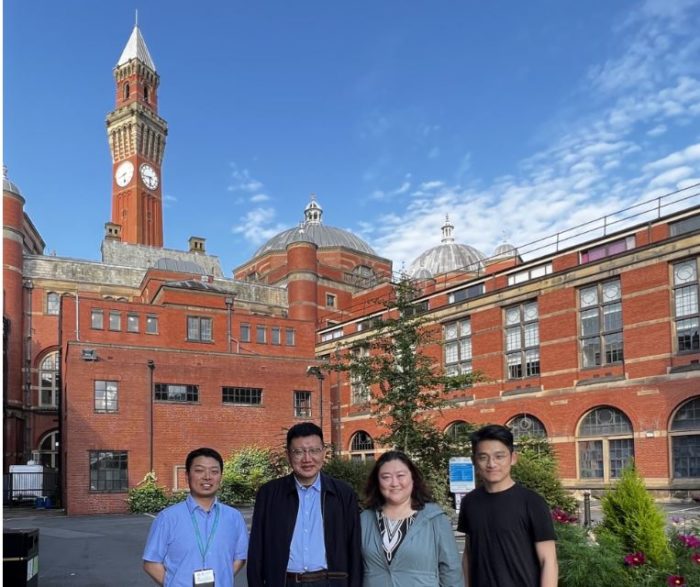
Impressions and Reflections on Visiting Birmingham in the UK
Impressions and Reflections on Birmingham in the UK[1]
July 30-31, 2024
ZHAO Kejin, YUAN Lijuan
On July 30th, after approximately a two-hour journey, departing from the scholarly haven of Oxford, rich with academic atmosphere, we arrived at the birthplace of the Industrial Revolution, Birmingham.! Birmingham, as the industrial hub of central England, is also the second-largest city in the UK after London, and it’s a magical place with many stories!
For many who still perceive the UK through the various news of the British royal family or the Premier League teams, it’s unavoidable to recognize the over 200 years of industrialization that the UK began. This era propelled human technology, wealth, art, and life to a peak period, significantly widening the modern development gap between the East and the West! We can’t help but ask, did all this originate merely from the bubbles rising in Watt’s eyes?
Next to our hotel was the ancient canal path of Birmingham, with many old buildings and facility remnants from its days as a loading and unloading dock still preserved. One can imagine the bustling scenes and the sweaty work environment of the past, as people laboured hard for a better future! In the period around 1776, Britain’s production was still backward, markets were fragmented, and there were some gaps between people and a life of more wealth and freedom! Many people traveled long distances, setting sail across the ocean to seek a free and beautiful world, while those who stayed had to think hard within the existing structure to seek breakthroughs!
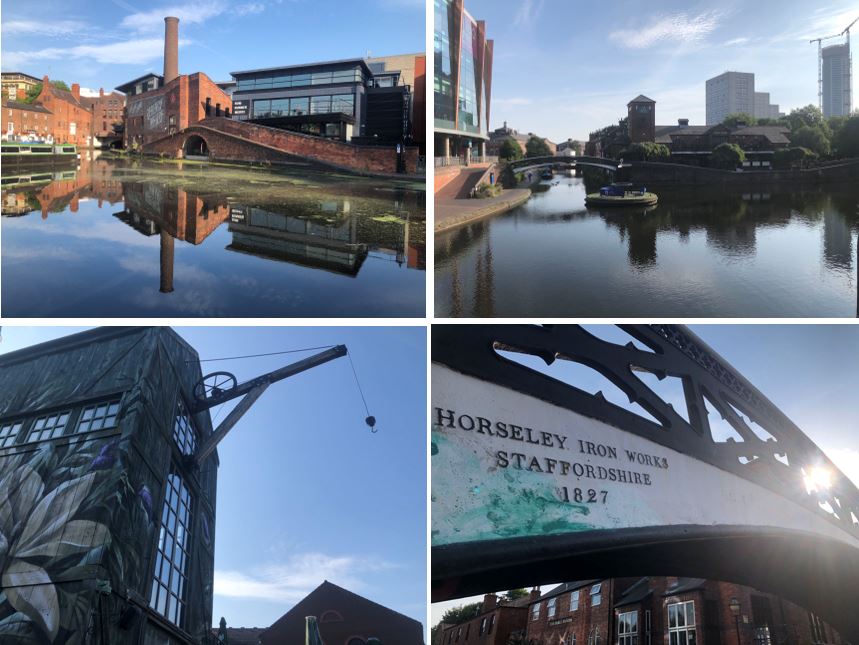
Top Left Photo: This is a view of the canal area in central Birmingham, featuring historical landmarks such as ‘Regency Wharf’ and ‘Rum Runner Works,’ part of the city’s extensive canal network. The photo shows the coexistence of red brick buildings and modern architecture, highlighting the blend of old and new in this area. Top Right Photo: This is Brindley place and its surrounding areas in central Birmingham, known for its beautiful canal scenery, historical buildings, and modern facilities. The modern buildings on the left contrast with the historical buildings on the right, with high-rise buildings and bridges over the canal adding layers to the cityscape, showcasing the city’s diverse development and vibrant urban character. Bottom Left Photo: This is a building in Birmingham’s canal area, with an old crane and pulley system on top, once used for canal cargo loading and unloading, symbolizing the canal trade and industrial activity of the past. The large mural depicting plants on its exterior wall combines industrial, artistic, and historical elements of the canal area. Bottom Right Photo: This is an iron bridge in Birmingham’s canal area, manufactured in 1827 by the Horseley Iron Works in Staffordshire, known for high-quality iron products. The bridge showcases 19th-century industrial technology and design, reflecting the engineering and manufacturing achievements of the British Industrial Revolution.
Birmingham is indeed the birthplace of the Industrial Revolution. However, the secret of British industrialization has not been extended to ecological research. Britain, an island nation surrounded by the sea, relied heavily on maritime transport. However, focusing only on the sea wouldn’t have led to the Industrial Revolution, as seen in Indonesia and India, where no such revolution occurred. The British Industrial Revolution was closely linked to canal digging, similar to China’s Grand Canal and the Red Flag Canal in Linzhou, Henan.
Before the 18th century, Britain had no canal system of its own. The presence of the Pennine and Cambrian Mountains caused rivers like the Thames, Severn, and Trent to flow into the North Sea and the Irish Sea, preventing inland water retention and hindering transportation. Carriage transport was backward. However, as factory handcrafts transformed into machine-driven large-scale industry, with factories emerging in 1721, Watt inventing the steam engine in 1776, trains appearing in 1830, and a nationwide railway network established by 1850, it’s clear that railways were a result, not a driver, of industrialization. Over a century before railways, industrialization accelerated due to the construction of the Bridgewater Canal in 1759.
The digging of canals was spurred by coal and iron ore discoveries in Manchester and Birmingham, with canal transport capacity far exceeding that of carriages. This success prompted British merchants to invest in canal systems. James Brindley planned the Grand Cross Canal, linking Liverpool on the west coast, the Mersey River, and London on the east coast, the Thames River, with the Humber River and Severn River ports. Birmingham, at the intersection of this canal, gained immense industrialization opportunities, poised at this historical crossroads to seize them.
Thus, Birmingham is an industrial city pulled by the Grand Cross Canal, the mother river of British industrialization. This foundation led to the development of the Grand Junction Canal, transforming Britain’s ecological system and setting the stage for industrialization. The engine of the British Empire was ignited, leading the UK into a new era of world history.
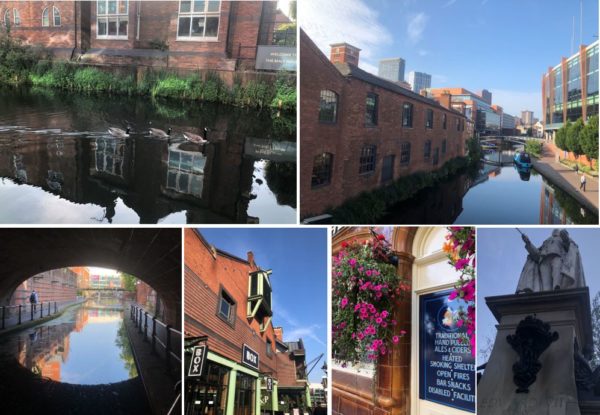
Top Left Photo: This is a serene section of the canal area in Birmingham, with three Canadian geese (Branta canadensis) leisurely swimming. The sign on the building’s lower right corner reads ‘The Malt House,’ a historic restaurant or pub in the canal area, showcasing the perfect blend of nature and man-made structures. Top Right Photo: This is a view of the canal area in central Birmingham, with historic red brick industrial or warehouse buildings on the left, now possibly repurposed for modern use, and modern glass buildings on the right, highlighting the stark contrast between old and new. Bottom Photo 1(from left to right): This is a view from inside a canal tunnel in Birmingham, looking out towards the red brick buildings and the small path along the canal, with bridges and modern buildings in the distance, showcasing the blend of old and new in the canal area. Bottom Photo 2: This is part of the ‘Mailbox’ building in central Birmingham, a landmark combining shopping, dining, hotels, and offices. The photo shows restaurant or bar signs like ‘BOX’ and ‘Pitcher & Piano,’ located within the Mailbox. The architectural style blends modern and traditional elements, reminiscent of commercial areas near Shanghai’s City God Temple, perhaps inspiring modern large shopping and entertainment complexes. Bottom Photo 3: This is the exterior of a traditional pub in Birmingham, with signs by the door listing services such as traditional hand-pulled ales and ciders, heated smoking area, open fire, bar snacks, and disabled facilities, reflecting the traditional décor and typical atmosphere of British pubs. Bottom Photo 4: This is a statue of Edward VII in Victoria Square, Birmingham, with the base inscription explaining his reign as King of the United Kingdom from 1901 to 1910. As the eldest son of Queen Victoria, during his reign, he significantly enhanced Britain’s position on the international stage and its social progress by promoting social reforms and modern diplomatic policies. Victoria Square is also home to many other historical monuments and artworks, as well as important buildings like the Birmingham Town Hall and the Birmingham Museum and Art Gallery.
If James Brindley’s planning of the Grand Cross Canal started the engine that ushered the UK into a new era of world history, then James Watt’s discovery of steam’s industrial value and his invention of the machines to harness that value radically transformed human production and lifestyle. Following Watt, many others pushed these unprecedented discoveries and inventions to new heights.
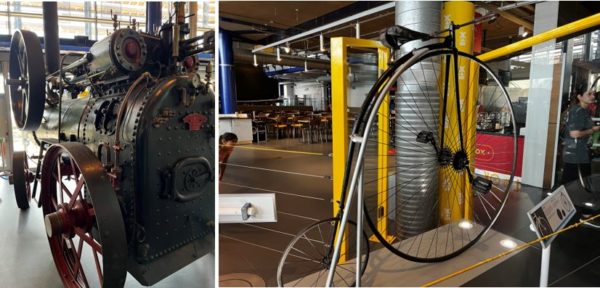
These two photos were taken at Birmingham’s Thinktank Science Museum, located at Millennium Point, an interactive science museum showcasing various exhibits from the Industrial Revolution to modern technology. Left Photo: This is an ancient steam locomotive, demonstrating the complexity and aesthetics of mechanical manufacturing during the Industrial Revolution. The design includes large drive wheels, a complex piping system, and various valves and instruments. Its working principle involves burning coal or wood to heat water, generating steam whose pressure drives pistons, which in turn rotate the wheels, showcasing the engineering achievements and technological progress of the steam power era. Steam locomotives were widely used in industrial and transportation fields in the 19th and early 20th centuries, propelling the progress of the Industrial Revolution. Right Photo: This is a high-wheeled bicycle (Penny-farthing) that was very popular in the late 19th century. The design aimed to increase riding speed since a larger front wheel could cover more distance per rotation. However, due to its instability and tendency to cause falls, it was later replaced by safer and more practical modern bicycles.
Our world is a time-space combination based on energy. With humanity’s current cognitive abilities, we can only perceive and utilize about 5% of time-space energy, with much of the unknown world awaiting our exploration! The exploratory spirit of Watt and his successors, given their limited resources, has already created such a brilliant situation. Imagine the future with countless possibilities, where we seek the value of life in the interplay of the finite and the infinite! What we can see is always just a small part of the totality we possess. Discovery pertains to stock; invention pertains to increment; exploration pertains to infinity. This perhaps embodies the profound and implicit meaning of Chinese words. In the longing for a better life, there is no difference among various races, countries, or civilizations!
During our two-day flying visit in Birmingham, another deeply touching aspect was the presence of a group of people from our homeland, overseas Chinese! For livelihood or studies, they left their homeland, rooted themselves here, and sought development at the intersection of Eastern and Western civilizations, facing imaginable difficulties and challenges! However, they are a wise group, finding suitable living spaces with their strong vitality, integrating into the local energy environment, and becoming one with it! Whether from Darwin’s natural selection or the Chinese saying that ‘a tree thrives by moving, and a person thrives by relocating,’ migration is about opening up new energy fields.
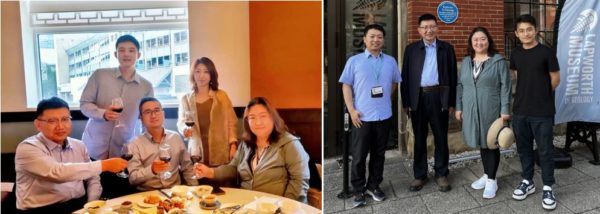
Left Photo: President Wang Shubin of the British Avenue Consulting Group with his colleagues (middle front row and back row) hosted a Cantonese meal for Professors Zhao and Yuan at Chung Ying Cantonese Restaurant, ranked third among the best Chinese restaurants in Birmingham. Right Photo (from left to right): Dr Yongjian Li, Prof ZHAO Kejin, Ms YUAN Lijuan and Dr Mengda WU in front of a blue plaque commemorating Professor Li Siguang at the University of Birmingham.
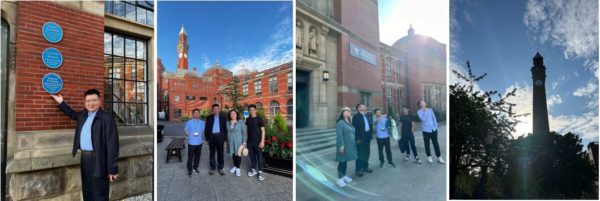
Photo 1(from left to right): Above the commemorative plaque for Professor Li Siguang pointed out by Professor Zhao Kejin, from top to bottom, are plaques for Charles Lapworth (1882-1923, pioneering work on mountain range formation), Frederick Shotton (1949-1974, advancing understanding of climate change), and Professor Li Siguang (1889-1971, geologist and politician, made pioneering contributions to Chinese geology and natural resource research, received a doctorate from the University of Birmingham in 1927). Photo 2: Chris and Maggie with Professors Zhao and Yuan in front of the Joseph Chamberlain Memorial Clock Tower (Old Joe) at the University of Birmingham’s Edgbaston Campus, showcasing the university’s history and neoclassical architectural style. Photos 3 and 4 (from left to right): Ms YUAN Lijuan, Prof ZHAO Kejin, Dr Yongjian Li, Dr Mengda Wu and Dr Deqing Rong of Birmingham University looking up at the clock tower.
The spread of human civilization is accompanied by human migration, with outward movement always being a positive choice for growth! A child cannot be sheltered under their parents’ wings forever, nor can a nation remain isolated in arrogance! The fusion of different bloodlines and genes gives birth to greater wisdom; stagnation and self-righteousness are undesirable! Buddhism teaches that despising others is a great sin, perhaps laying a spiritual foundation for integration! This integration does not mean the disappearance of uniqueness but finding commonality in differences, learning from others to accurately position oneself, and giving the unknown world necessary respect![2] Just like Birmingham’s extensive canal network or China’s historical Grand Canal, utilizing existing waterways and creating new channels have facilitated communication and trade across regions, diminishing divisions and differences, while conflict and opposition often come with isolation and barriers!
As the train heads towards Manchester, the scenery outside the window keeps shifting, and the future awaits our continuous exploration…
Edited by Xiangqun Chang, 1st August 2024
[1] Editor’s Note: This blog is edited by Xiangqun Chang. The extensive footnotes aim to use the blog as an example for help to understand the Global China Academy. The captions of all the photos, proofreading, and English translation were assisted by ChatGPT-4o.
- Professor ZHAO Kejin, Vice Dean of the School of Social Sciences and Director of the Global Industry Research Institute at Tsinghua University, along with his wife, Yuan Lijuan, were invited by the Global China Academy to conduct an investigation tour and academic exchanges in the UK from July 27 to August 24, 2024. The theme of the investigation tour is ‘Modernization of the UK and Its Global Development Experience.’ Their travel route included London-Oxford-Birmingham-Manchester-Glasgow-London-Cambridge, etc. At each location, volunteers arranged by the academy were present to receive or accompany them.
- We would like to thank the Zhejiang UK Association (ZJUKA) for providing contacts in Oxford, Birmingham, and Glasgow. ZJUKA was one of the supporters of the 2nd Global China Dialogue on ‘Transculturality and New Global Governance’ in 2015. About the ‘transculturality’, in the postscript of the Proceedings of the 1st Global China Dialogue: The Experience of China’s Modernization from a Comparative Perspective, I pointed out, ‘Another key outcome of this dialogue was the recognition of the similarities and differences between various types of dialogue. Cross-Cultural Dialogue refers to exchanges between people from different cultural backgrounds, aiming to understand and respect each other’s cultural differences; Intercultural Dialogue involves deep communication between different cultures to build bridges and reduce misunderstandings and conflicts; Transcultural Dialogue goes beyond the boundaries of a single culture, integrating elements from different cultures to create new cultural consensus. The Global China Dialogue platform will address the challenges of global governance through Transcultural Dialogue and explore the possibilities of mutual benefit, symbiosis, coexistence, and prosperity’ (Page 45, 2016).
- The book Walking for Peace: Transcultural Experiences from a Journey in China, edited by ZJUKA’s founding president Lady Xuelin Li Bates, has been published in both English and Chinese by our Global Century Press. This book is based on the blog posts of her husband, Lord Michael Bates, during his walk from Beijing to Hangzhou in 2015, marking the 70th anniversary of China’s victory in the Anti-Japanese War. The book is part of the ‘Three Eyes Transcultural Series,’ requiring authors to write with three perspectives: ethnic Chinese, culturally Chinese, or having some overseas living experience, and once own working experience. As a ‘son-in-law of China,’ some of Lord Bates’ content reflects this perspective. The book also presents a comparative viewpoint; while Lord Bates served as the UK’s Minister of State for International Development, he contemplated the shipbuilding industries of China, Korea, and the UK during his walk along the Grand Canal.
- The Birmingham visit of ZHAO Kejin and YUAN Lijuan was hosted and arranged by Wang Shubin, President of the UK Pathway Consultancy and Executive President of the Birmingham Chinatown Chamber of Commerce, along with his colleagues. The publication of this blog post on the Global China Academy’s website is also a token of appreciation for their assistance during Professor Zhao and Ms. Yuan’s visit to Birmingham.
[2] Editor’s Note:
- This blog, co-authored by ZHAO Kejin and YUAN Lijuan, vividly presents the 16-character methodology of renowned Chinese sociologist and anthropologist Fei Xiaotong: ‘Appreciate the beauty of oneself, appreciate the beauty of others, share the beauty with all, and achieve harmony in the world.’ For example, Mr Shubin Wang welcomed Professor Zhao and Ms. Yuan with Cantonese cuisine at Chung Ying Cantonese Restaurant, ranked third among the best Chinese restaurants in appreciating Chinese food in the UK. Numerous photos of canals, buildings, daily life, plaques commemorating scientists, and museums exhibit ‘appreciating the beauty of others.’ The coexistence of traditional and modern, natural, cultural, industrial elements, and diverse food cultures demonstrates ‘sharing the beauty with all.’ In their reflections at the end of the blog, the authors mention that ‘finding commonality in differences means learning from others to accurately position oneself and giving due respect to the unknown world!’ This echoes the transculturality promoted by the Global China Academy and, in some sense, surpasses the concept of ‘achieving harmony in the world,’ resonating with Fei’s later advocacy of ‘harmony but not uniformity.’
- Global Century Press publishes a series of books on eight themes, including: Chinese Concepts, Chinese Discourse, Understanding China and the World, Comparative Perspectives on China and the Chinese, Globalization of Chinese Social Sciences, “Three Eyes” Transcultural, Research on China’s Urbanization, and Cutting-edge and Avant-garde Studies. Each series includes academic works, policy research, investigation reports, and popular humanities and social science books. The book Walking for Peace has the nature of an investigation report, featuring over 300 colour photos and numerous photo descriptions provided by authors with sociological training, reflecting methods of visual sociology and visual anthropology. The blog also has a certain global and comparative perspective and many photos. Global Century Press looks forward to adding a new book to the ‘Three Eyes Transcultural Series’ titled ‘Investigating Modernization and Global Development Experience of Modern Britain’ (tentative title), with this blog possibly being included.

行走英国之伯明翰印象及感想
行走英国之伯明翰印象及感想[1]
2024年7月30-31日
赵可金 袁丽娟
7月30日早,经过大概两小时的车程,我们就从浓郁书卷气息的学术胜地的牛津来到了工业革命的发祥地伯明翰!伯明翰,作为英国中部的工业重镇,也是仅次于伦敦的英国第二大城市,同时它是个神奇的有故事的地方!
如果很多人还在从英王室的各种新闻、从英超的各大球队来认识英国,不可回避的是英国开启的两百多年的工业化时代,这一时代把整个人类的科技、财富、艺术、生活等推向了一个巅峰时期,也正式拉开了东西方近代的发展差距!我们不禁会问,这一切的发端,难道仅仅是因为瓦特眼中那一串串升腾的气泡吗?
酒店旁边便是伯明翰古老的运河故道,至今还保存了当年作为装卸码头的很多老建筑和设施遗迹,可以想象出当年的人声鼎沸场景和挥汗如雨的工作画面,人们为了获得更美好的未来生活,努力劳作!1776年前后的英国,生产还是落后的,市场还是割裂的,人们跟拥有更多财富的自由生活总有那么一段距离!很多人不惜长途跋涉,扬帆远行去大洋彼岸,去寻找自由美好的世界,而留下来的人,更需要在固有的结构中去苦苦思考,寻求突破!

左上图:这是位于英国伯明翰市中心的运河区景色,其地标包括“Regency Wharf”和“Rum Runner Works”这两个历史悠久的伯明翰运河网络的一部分。照片中红砖建筑和现代建筑的并存展现了这个区域的新旧结合。右上图:这是伯明翰市中心的运河区布林德利广场(Brindleyplace)及其周围区域,这里以其美丽的运河景观、历史建筑和现代设施而闻名。照片左侧是现代建筑,右侧前面是历史建筑,后面的高层建筑和运河上的桥梁增加了城市景观的层次感。运河上有一座拱桥连接两岸。这种新旧建筑的结合展示了伯明翰城市发展的多样性,以及既有历史底蕴又充满现代活力的城市特色。左下图:这是伯明翰运河区的一栋建筑,建筑上方有一个旧式吊臂和滑轮装置,这个吊臂曾用于运河货物的装卸,象征了过去的运河贸易和工业活动,显示了这个区域的工业历史。其外墙上有一幅巨大描绘植物的壁画,展示了伯明翰运河区工业、艺术与历史元素的结合。右下图:这是伯明翰运河区的一座铁桥,是由位于斯塔福德郡的以高质量铁制品闻名的霍斯利铁工厂(Horseley Iron Works)于1827年制造的。此桥梁展示了19世纪的工业技术和设计风格以及工业革命时期英国在工程和制造方面的成就。
在伯明翰是工业革命的发源地。然而,对于英国工业化的秘密,一直没有拓展到生态体系的研究上。英国是一个岛国,四周都是海洋,英国运输更依赖于海洋。然而,如果只关注海洋,是不会产生工业革命的,就像印度尼西亚、印度都没有产生工业革命。英国的工业革命与运河挖掘有很大关系,类似于在中国的大运河及河南林州看到的红旗渠。
英国在18世纪之前没有自己的运河体系。由于奔宁山脉和坎布里亚山脉的存在,导致英国的泰晤士河、奎文河、特伦特河等均向四周流入北海和爱尔兰海,英国内陆存不住水,交通很不便利,马车运输很落后。然而,随着工厂手工业向机器大工业转变,1721年出现了工厂,1776年瓦特发明蒸汽机,1830年出现了火车,1850年才建立了全国铁路网。显然,铁路是工业化的结果,不是工业化的动力。在铁路出现之前的一百多年时间里,工业化之所以加速发展,与1759年开凿布里奇沃特运河有关系。
之所以开凿运河,与曼彻斯特和伯明翰发现煤矿和铁矿有关系,运河运力要大大高于马车。这一运河的成功刺激了英国商人集资开凿运河体系。詹姆斯·布林德利规划了大交叉运河(The Grand Cross),将西部港口利物浦-默西河和东部港口伦敦泰晤士河、东北港口赫尔的亨伯河和西南港口布里斯托塞文河连为一体,伯明翰就处于大交叉运河的交叉点上,伯明翰获得了工业化的巨大机遇。在这样一个历史交叉点上,等待着伯明翰的就是能否抓住机遇了。
从这个意义上来说,伯明翰是大交叉运河拉来的工业城市,大交叉运河是英国工业化的母亲河。后来,在这一基础上,大交叉运河发展成为大串联运河(The Grand Junction),英国的生态体系彻底改变了,工业化的历史舞台已经搭建,日不落帝国的发动机已经开启,英国率先步入了世界历史的新时代。

左上图:这是伯明翰运河区的一段宁静水域,有三只加拿大鹅(Branta canadensis)在悠闲地游动。建筑右下角的标牌显示“The Malt House”(麦芽屋),是运河区的一家历史悠久的餐馆或酒吧,展示了自然与人造建筑的完美结合。右上图:这是伯明翰市中心运河区的一个景象。照片左侧是历史悠久的红砖工业或仓库建筑,现在可能被改造成现代用途。右侧是现代的玻璃建筑,与历史建筑形成了鲜明的对比。下图一(自左至右):这是伯明翰运河区的一个运河隧道内的视角向外看,可以看到红砖建筑和运河岸边的小路,运河上方的桥梁和远处的现代建筑,展示了伯明翰运河区新旧建筑融合的特点。下图二:这是位于英国伯明翰市中心的“Mailbox”(邮箱)建筑的一部分,这个标志性建筑集购物、餐饮、酒店和办公等功能于一体。照片中可以看到一些餐厅或酒吧的标志,如“BOX”和“Pitcher & Piano”,这些都是位于 Mailbox 内的餐饮场所。Mailbox 的建筑风格结合了现代和传统元素,有点像上海的城隍庙附近的商业区,也许现代大型购物娱乐等综合体由此获得了灵感。下图三:这是英国伯明翰一家传统酒吧的外观,门旁的标牌上写的服务项目包括传统手工拉制啤酒和苹果酒、加热的吸烟区、开放火炉、酒吧小吃、残疾人设施,体现了英国酒吧的传统装饰风格和典型氛围。下图一:这是位于伯明翰维多利亚广场(Victoria Square)的一座雕像,雕像基座上刻字说明这是爱德华七世(Edward VII),他在1901-1910年期间担任英国国王。作为维多利亚女王的长子, 他在统治英国期间,通过推动社会改革和现代外交政策,显著提升了英国在国际舞台上的地位和社会进步,该雕像是为了纪念他对英国的贡献而建造的。广场上除了爱德华七世的雕像外,还有许多其他具有历史意义的纪念碑和艺术品。维多利亚广场也是市政厅(Birmingham Town Hall)和伯明翰博物馆与美术馆(Birmingham Museum and Art Gallery)等重要建筑的所在地。
如果说詹姆斯·布林德利规划的大交叉运河(The Grand Cross)开启了英国率先步入世界历史新时代的发动机,那么詹姆斯·瓦特发现的蒸汽的工业价值,进而发明了转化这种价值的机器,使人类的生产生活的样态发生了翻天覆地的变化。此后,一群又一群的后来者,把这场史无前例的发现和发明大潮推向一个个新高度!

这两张照片拍自伯明翰的Thinktank伯明翰科学博物馆(Thinktank Birmingham Science Museum),该博物馆位于伯明翰千禧点(Millennium Point),是一个互动式科学博物馆,展示了从工业革命时期的蒸汽机车到现代科技的各种展品。左图:这是一台古老的蒸汽机车,展示了工业革命时期机械制造的复杂性和美学。其外观包括大型的驱动轮、复杂的管道系统和各种阀门和仪表。其工作原理是通过燃烧煤炭或木材来加热水,产生蒸汽,蒸汽的压力驱动活塞运动,进而带动轮子旋转,展示了蒸汽动力时代的工程技术成就及科技进步。蒸汽机车曾在19世纪和20世纪初期广泛用于工业和运输领域,推动了工业革命的进程。右图:这是在19世纪末期非常流行的高轮自行车(Penny-farthing),也被称为“前高后低自行车”。前高后低自行车的设计初衷是为了增加骑行的速度,因为较大的前轮每转一圈可以覆盖更大的距离,但由于其稳定性差和容易导致摔倒受伤,后来被更加安全和实用的现代自行车所取代。
我们这个世界,是个以能量为基准的时空组合。以人类现有的认知能力和水平,我们仅仅可以感知和利用时空能量的5%左右,而大量的未知世界等着我们去探索!瓦特以及他的后来者所具有的探索精神,在他们有限的资源前提下,已经开拓出如此辉煌的局面。试想未来,我们更是有无数种可能,在有限与无限的博弈中,去寻求生命的价值!我们所能看到的,总是我们所拥有的总和的一小部分。发现,针对存量;发明,针对增量;探索,针对无限量,这也许就是汉语词意的博大精深,准确而含蓄!而在对美好生活的向往上,各个种族、国家、文明,又毫无差别!
在伯明翰仅仅两天的行程中,另一个让我触动很深的是这里的一群人,一群来自故乡的人,海外华人!他们为生计、为学业……离开故土,扎根在这里,在东西方文明的交集地带寻求发展,所面对的困难和挑战可想而知!但是,他们又是智慧的一群,以他们强大的生命力,找到了合适自己的生存空间,发挥自身的能量优势,利用当地的能量环境,融为一体!无论从达尔文的自然选择出发,还是中华文化讲的树挪死人挪活的古训,迁徙就是开辟新的能量场。

左图:英国大道咨询集团的王澍斌总裁(前排中间)与他的同事在英国最佳中餐馆排名第三的伯明翰粤菜馆(Chung Ying Cantonese Restaurant)用粤菜为赵袁二位老师接风。右图:伯大的李永健博士和武孟达博士在伯明翰大学的楼前与赵袁二位老师在有李四光教授的蓝色纪念牌前合影。

图一 (从左到右):在赵可金教授手指着的李四光教授的纪念牌的上面,自上而下依次是:查尔斯·拉普沃斯(Charles Lapworth, 1882-1923,进行了关于山带形成的开创性工作)、弗雷德里克·肖顿(Frederick Shotton, 1949-1974,推进了对气候变化的理解)和李四光教授(Professor Li Siguang, 1889-1971,地质学家和政治家,为中国地质学和自然资源研究做出了开创性贡献,他于1927年获伯明翰大学博士学位)。图二:Chris和Maggie与赵袁二位老师在伯明翰大学主校园爱德巴斯顿校园(Edgbaston Campus)的一个标志性建筑钟楼前合影。这座钟楼的正式名称是“约瑟夫·张伯伦钟楼”(Joseph Chamberlain Memorial Clock Tower),又被称为“老乔”(Old Joe)。这一建筑群展示了该大学的历史和新古典时期的建筑风格。图三、四:赵袁二位老师与伯大的李永健博士,武孟达博士,荣德清博士仰望钟塔。
人类文明的传播伴随着人类迁徙的脚步,脚尖向外永远都是成长的正态选择!一个孩子不能闭锁在父母的羽翼下,一个民族不能封闭在自大的氛围中!不同血脉基因的融合,诞生出更强大的智慧,固步自封、自以为是不可取!佛家讲轻视别人是极大的罪恶,也许就是为融合做精神托底!而这种融合,不是独特性的消失,而是在差异性中找共性,是以他人为鉴,给自己准确的定位,给予未知世界必要的尊重![2] 就像伯明翰四通八达的运河,像中国历代修葺的大运河,其中有固有河道的利用,也有人工接洽的开凿,顺畅的水道便利了东西南北的沟通,互通有无淡化了分歧和差异,而冲突和对立,往往伴随的都是孤立隔绝和阻断!
列车向着曼彻斯特行驶,窗外的景色不断推移,前方等着我们不断去探索……
常向群 编,2024年8月1日
[1] 编者注:本博客图文由常向群编辑并加注,较多的脚注及图说旨在以此博客为例帮助读者了解全球中国学术院。校对和图说由ChatGPT-4o辅助完成:
- 清华大学社会科学院副院长、全球产业研究院院长赵可金教授及夫人袁丽娟女士应全球中国学术院的邀请,于2024年7月27日至8月24日到英国展开调研、访问和学术交流。调研访问的主题是“近代英国现代化及其全球发展经验研究”。他们的游走路线是伦敦-牛津-伯明翰-曼彻斯特-格拉斯哥-伦敦-剑桥等。每到一处都有由学术院安排的志愿人员接待或陪同。
- 感谢英国浙江联谊会(ZJUKA)帮我们提供了牛津、伯明翰和格拉斯哥的接待人员。ZJUKA曾经是第二届全球中国对话“转文化(transculturality)与新型全球治理”(2015)的支持单位。关于”转文化“,我在第一届全球中国对话”中国现代化进程的经验教训与其它发展中国家和地区之比较“文集的“编后语”中曾指出,“此次对话的另一个关键成果是认识到几种对话的异同。跨文化对话(Cross-Cultural Dialogue)指不同文化背景的人之间的交流,旨在理解和尊重彼此的文化差异;际文化对 话 (Intercultural Dialogue)指在不同文化之间的深度交流,以建立沟通桥梁,减少误解和 冲突;转文化对话(Transcultural Dialogue)指超越单一文化界限的交流,融合不同文化元 素,创造新的文化共识。全球中国对话平台将通过转文化对话来应对全球治理的挑战,并探索互惠共生、共存和繁荣的可能性“(第45页, 2016)。
- ZJUKA的创始会长李雪琳·贝茨勋爵夫人(Lady Xuelin Li Bates)编辑的《为和平徒步——中国之旅的转文化体验》一书由我们环球世界出版社出版了英文版和中文版。此书是基于雪琳的丈夫麦克·贝茨勋爵(Michael Bates)在2015年中国抗日战争胜利70周年之际的北京—杭州徒步日志博文。此书被列为“三只眼转文化系列丛书”,要求作者在写作时带有华人、文化华人或在海外有一定生活体验的华人和职业人三重视野。麦克·贝茨勋爵是“中国女婿”,书中有的内容带有相关视野。此书还呈现出一定的比较视野,麦克时任英国国际发展部国务大臣,在沿着大运河徒步时也对中国、韩国和英国的造船业做了一定的思考。
- 这次赵可金和及袁丽娟的伯明翰之行是由英国大道咨询集团总裁兼伯明翰华埠商会执行会长的王澍斌先生及他的朋友Chris和Maggie接待安排的。全球中国学术院网站发表这篇博文也是表达对他们在赵教授及夫人的伯明翰之行提供帮助的感谢。
[2] 编者注:
- 赵可金和及袁丽娟合写的“伯明翰印象记”,生动地呈现了中国著名社会学家和人类学家费孝通的16字方法论:“各美其美、美人之美、美美与共、天下大同”。例如,英国大道咨询集团的王澍斌总裁在英国最佳中餐馆排名第三的伯明翰粤菜馆(Chung Ying Cantonese Restaurant)用粤菜为赵教授和袁女士接风(在英国欣赏中国美食);大量的运河、建筑、生活、科学家纪念牌、博物馆等照片呈现的是“美人之美”;从传统到现代、自然、人文与工业以及不同饮食文化的并存,展现出“美美与共”的态势;作者在文章最后的体会中提到“这种融合,不是独特性的消失,在差异性中找共性,是以他人为鉴,给自己准确的定位,给予未知世界必要的尊重”,这个观点与注释1中几次提及的全球中国学术院推动的转文化观念非常接近,在某种意义上超越了“天下大同”的境界,与费先生晚年倡导的“和而不同”理念有异曲同工之妙。
- 环球世界出版社出版系列丛书,目前研发了八个主题,如:中华概念、中华话语、读懂中国与世界、中国与中华比较视野、中国社会科学全球化、“三眼”转文化、中国城镇化研究和新锐与前沿。每套丛书包括学术著作、政策性研究、考察报告、人文社科普及性读物等不同形式的著述。《为和平徒步》一书有考察报考的性质,包括了300多幅彩照,有社会学专业训练的作者提供的大量的图片说明,体现了视觉社会学和视觉人类学的方法。“伯明翰印象记”一文也具有一定的全球和比较视野及许多照片。环球世界出版社期待在“三只眼转文化系列丛书”中增加一本新书《近代英国现代化及其全球发展经验考察录》(讨论书名),此文可作为其中的一篇。
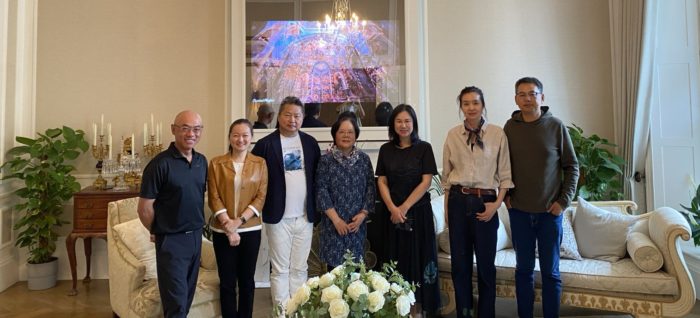
Global China Academy’s Team building in July 2024
On April 17, Professor Xiangqun Chang visited GCA Fellows at the University Club at Oxford. The fellows are Professor David Parkin, Professor Robin Cohen, and Professor Maria Jaschok. In the morning, they conducted a broad range of discussions. During lunchtime, in addition to discussing work, Professor David Parkin suggested that we should also add a little living to our life. In the afternoon, Xiangqun and Maria discussed detailed work on the GCA Board of Trustees. It was a very productive day.
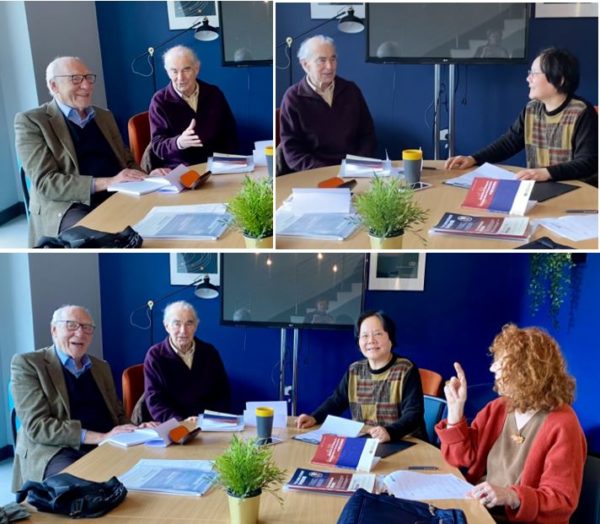
From left to right: Robin Cohen, David Parkin, Xiangqun Chang, and Maria Jaschok. The discussion meeting was similar to a brainstorming session. Based on incomplete audio records, the following topics were covered:
- Transculturality:
- Definition and examples of transcultural practices.
- The concept of transculturality as a tool for understanding global dynamics beyond globalization.
- Comparison between Chinese and Western approaches to transculturality.
2. Reciprocity and Social Exchange:
- Different types of reciprocity: generalized, balanced, and negative exchange.
- The role of reciprocity in social relationships and its implications in different cultural contexts.
3. Academic Contributions and Challenges:
- The need for a Chinese school of sociology and its contributions to global social science.
- The challenges faced by Chinese academics in the global academic landscape.
- Strategies for integrating Chinese perspectives into global academic discussions.
4. Social Practices and Their Cultural Significance:
- The influence of Chinese cultural practices on social relationships and community building.
- Examples of social practices in Chinese villages and their implications for social structure.
5. Historical and Comparative Studies:
- Comparative studies on modernization in different countries.
Historical encounters between Europe and China and their impact on cultural exchange. - The role of Chinese academics in documenting and analyzing these historical interactions.
6. Globalization and Modernization:
- The evolution of globalization and its various forms.
The concept of modernization in China and its comparison with Western perspectives. - The impact of globalization on local cultures and practices.
7. Role of Chinese Women and Feminism:
- The development of Chinese feminism and its integration into global feminist discourse.
- Historical perspectives on Chinese women’s roles and contributions.
8. Networking and Collaboration:
- The importance of collaborating with similar institutions to sustain the mission of the Global China Academy.
- Potential partnerships with organizations like the United Nations Alliance of Civilizations (UNAOC).
9. Impact and Sustainability of the Global China Academy:
- Strategies for ensuring the sustainability of the academy.
The role of publications and academic dialogues in promoting the academy’s mission. - The importance of engaging younger generations in the academy’s work.
10. Fieldwork and Ethnographic Studies:
- Personal anecdotes and experiences from fieldwork in China.
- The significance of understanding local contexts and social dynamics through ethnographic research.
11. Political and Cultural Mapping:
- The role of maps in representing cultural and political relationships.
- The influence of mapping practices on understanding global connections and power dynamics.
12. Challenges of Publishing Uncensored Chinese Work:
- The difficulties in publishing authentic, uncensored academic work on China.
- The role of the Global China Academy in providing a platform for such publications.
13. Global Governance for AI:
- This is the theme of the 9th Global China Dialogue, which will take place at Tongji University in China. It is the first time the event will be held in China, and it will alternate between the UK and China in the future.
- The preparations are ongoing.
On April 27, the GCA team met for a one-day occasion. In the morning, some of us played golf at Hill Hill Golf Club. During the lunch meeting, it was agreed that Mr. Kai Liang would join us as Event Officer of GCA and Ms YU Li as Project Manager. In the afternoon, the team went to Brocket Hall for a walk and had dinner at the Real China Restaurant at the Galleria Outlet Shopping Centre in Hatfield. Thus, the sixth ‘walk and talk’ route was developed.
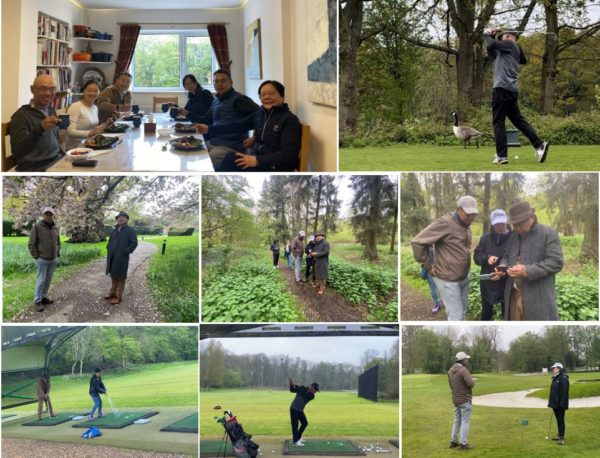
Participants in the day’s activities in the top photo from left to right: Kai Liang (Event Officer), Katie Zheng (Administrative Manager), Alan Fang (Legal Adviser), Yu Li (Project Manager), David Liu (Logistics Manager), and Xiangqun Chang (President).
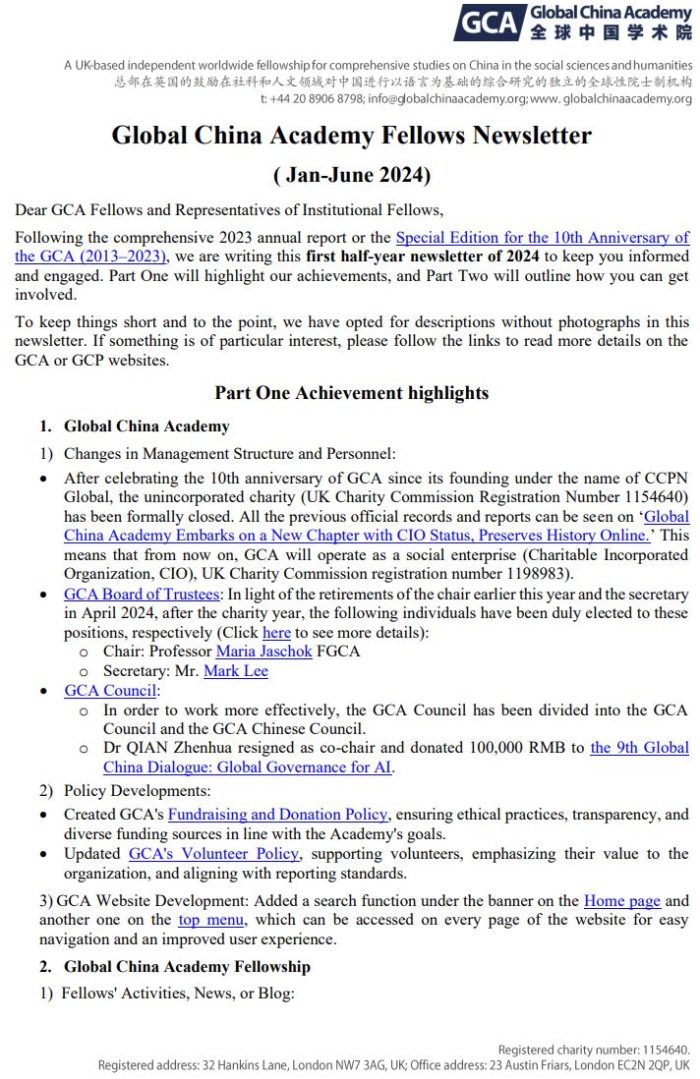
Global China Academy Fellows Newsletter (Jan-June 2024)
Dear GCA Fellows and Representatives of Institutional Fellows,
Following the comprehensive 2023 annual report or the Special Edition for the 10th Anniversary of the GCA (2013–2023), we are writing this first half-year newsletter of 2024 to keep you informed and engaged. Part One will highlight our achievements, and Part Two will outline how you can get involved.
To keep things short and to the point, we have opted for descriptions without photographs in this newsletter. If something is of particular interest, please follow the links to read more details on the GCA or GCP websites.
Part One Achievement highlights
- Global China Academy
1) Changes in Management Structure and Personnel:
- After celebrating the 10th anniversary of GCA since its founding under the name of CCPN Global, the unincorporated charity (UK Charity Commission Registration Number 1154640) has been formally closed. All the previous official records and reports can be seen on ‘Global China Academy Embarks on a New Chapter with CIO Status, Preserves History Online.’ This means that from now on, GCA will operate as a social enterprise (Charitable Incorporated Organization, CIO), UK Charity Commission registration number 1198983).
- GCA Board of Trustees: In light of the retirements of the chair earlier this year and the secretary in April 2024, after the charity year, the following individuals have been duly elected to these positions, respectively (Click here to see more details): Chair: Professor Maria Jaschok FGCA; Secretary: Mr. Mark Lee
- GCA Council: In order to work more effectively, the GCA Council has been divided into the GCA Council and the GCA Chinese Council. Dr QIAN Zhenhua resigned as co-chair and donated 100,000 RMB to the 9th Global China Dialogue: Global Governance for AI.
2) Policy Developments:
- Created GCA’s Fundraising and Donation Policy, ensuring ethical practices, transparency, and diverse funding sources in line with the Academy’s goals.
- Updated GCA’s Volunteer Policy, supporting volunteers, emphasizing their value to the organization, and aligning with reporting standards.
3) GCA Website Development: Added a search function under the banner on the Home page and another one on the top menu, which can be accessed on every page of the website for easy navigation and an improved user experience.
2. Global China Academy Fellowship
1) Fellows’ Activities, News, or Blog:
- In order to better engage GCA Fellows, it has been decided to send two GCA Newsletters each year starting from 2024.
- We also posted some of our Fellows’ activities on GCA website (in reverse order), e.g.:
- Global China Academy Board of Trustees Chair Participates in the 11th WWUPF in Zhengzhou, China, May 25-29
- The President of Global China Academy, Professor Xiangqun Chang, visited GCA Fellows at the University of Oxford in April (Click here to find related contents).
- Global China Academy Council Chair, Professor Tony McEnery’s Academic Activities in Hong Kong and China, from March to April
- We have issued invitations to some GCA Fellows and Fellow-related academics in China to visit the UK from July to August. They will stay in our Fellows’ Home during their time in London, such as:
- Professor ZHU Guanglei FGCA and his family. He is the former Vice-President of Nankai University, China, and a keynote speaker of the 5th Global China Dialogue.
- Professor ZHAO Kejin and his family. He is the Deputy Dean of the School of Social Sciences and the Director of Global Industry at Tsinghua University. He made closing remarks at the 6th and 7th Global China Dialogues in person and online respectively.
- Professor WANG Tianfu, Dean of the School of Social Sciences at Tsinghua University, who will lead a delegation from four universities in China, including Tsinghua, Renmin, and Fudan.
2) Fellowship:
- HMRC listed GCA among its ‘approved learned societies and professional organisations’ to facilitate GCA Fellowship subscriptions.
- To maintain the highest standards of GCA Fellows, no more than eight fellowships will be awarded per annum, including Full Fellows, Associate Fellows, and Institutional Fellows. This policy will be reviewed accordingly (Click here to see Fellows awarded in 2023).
- Updated the process and timetable of Guidance for Nomination (see p. 5).
- Updated Fellowship Benefits and Obligations:
- Added benefit number 1 ‘Global promotion of the academic publications and activities of GCA Fellows’.
- Added a tailor-made package service for different types of GCA Fellows-related delegations (see a 7-day package as an example).
- Added the sixth ‘walk and talk’ route, including tea and lunch, at and around the GCA Fellows’ Home.
- The GCA Fellows award ceremony in 2024 will take place at the GCD9 at Tongji University. GCA will cover the cost for those who wish to receive their awards in Shanghai, China.
3. Global Century Press
1) Activities:
- Originally initiated for the Journal of Chinese for Social Science (JCSS), the 2nd China-Focus Research Forum was held both offline and online at the GCA Centre on June 8, 2024.
- GCP colleagues participated in numerous events at the London Book Fair (LBF) from March 12-14 and engaged with professionals and authors during the events (click here for more details).
2) Regulations and Policy:
- GCP became a member of The Association of Learned and Professional Society Publishers (ALPSP).
- Updated the Open Access Policy, clarifying different types of ‘processing charges,’ including those for journals and journal articles, books, and book chapters.
- Published a new edition of the Global Century Press House Style Guide, which includes revised descriptions of each journal and book series and our unique ‘Dual Language Information’ section.
3) Standardization Process:
- GCP began its process of standardisation across its publications.
- Some journals and books are now available on an open access basis on the GCP website, and DOIs have been submitted to Crossref, e.g., https://globalcenturypress.com/product-category/journals-periodicals/Journal-China-Global-Comparative-Perspectives.
- This process will continue through 2024.
4. The 9th Global China Dialogue
- The Ministry of Education of China has approved Tongji University’s application for GCA to be a co-organiser of the 9th Global China Dialogue (GCD9) at Tongji University, Shanghai, on November 29th, 2024.
- It has been agreed that the GCD series will be held on the last Friday in November each year, alternating between China and the UK.
Part Two GCD Fellows’ involvements
GCA Fellows constitute the driving force behind GCA, leveraging its publications and dialogue forums as two platforms for dual successes. We invite you to get involved with GCA in the following ways:
- Send us information about your academic activities for the News & Blog section of the GCA website.
- Nominate different types of GCA Fellows. See: Fellowship nominations and to learn more.
- Contribute to GCA publications in various forms. Learn more.
- Participate in or recommend speakers for the GCD9. Learn more.
- Make any suggestions: info@globalchinaacademy.org.
As we look forward to the second half of the year, we are excited about the numerous opportunities and collaborations that lie ahead. We encourage all GCA Fellows to remain actively involved, share your academic pursuits, and contribute to our endeavours. Your engagement and participation are crucial to our continued success and the advancement of our shared goals.
Thank you for your dedication and support. Together, we will continue to make significant strides in our academic and social missions.
Warm regards,
Professor Xiangqun Chang 常向群FRSA FGCA
President of Global China Academy
Honorary Professor of University College London (2015-20)
Distinguished Professor of Nankai University
Professor Peter Schröder FRFAB FGCA
Vice President for Fellowship, Global China Academy
Professor of the History of Political Thought at Faculty of Social & Historical Sciences, UCL
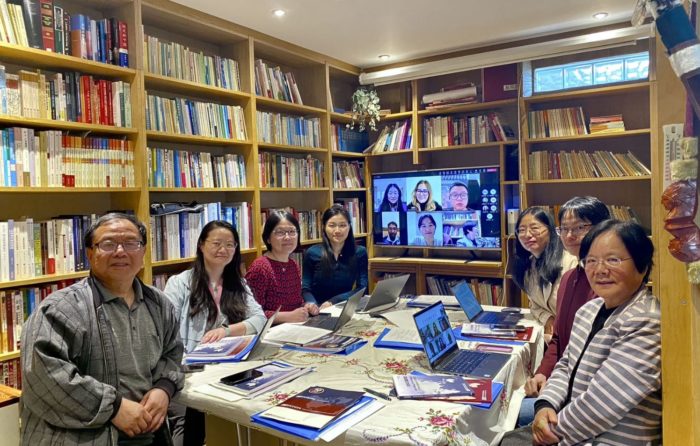
Global China Academy’s Activities in June 2024
We typically update the News and Blog section on a monthly basis. Due to the differing nature of activities and events, this page has categorized them into two types based on the missions of the Global China Academy. Within each category, the items are listed in reverse chronological order. However, our own events will always be placed at the top.
Academic mission
Following the 1st China-Focus Research Forum held on May 11th, 2023 (click here to find related news and photos), at SOAS, University of London, organized jointly by the student societies with support from the language teaching staff of SOAS, LSE, and King’s College London, the 2nd China-Focus Research Forum was held at the Global China Academy Centre both offline and online on June 8th, 2024.
Programme
Date and Time: 8th June 2024, 1-5 pm BST
Location: Global China Academy
Chair: Zhonghan Lin, PhD candidate in the School of Education, Communication & Society at King’s College London
1:00 – 1:10 pm Opening speech & warming up
1:10 – 1:35 pm
‘The Future of China’s Global Influence: A Theoretical Analysis of Peaceful and Conflictual Trajectories’
by Subham Kumar Kanu, The Maharaja Sayajirao University of Baroda, Vadodara, Gujarat, India
1:35 – 2:00 pm
‘The Baby-Eating Barbarians: Imagining and Constructing Chinese Images of Europeans in Late Ming and Early Qing Period’
by CHAN Pui To, Jack, The University of Hong Kong
2:00 – 2:25 pm
‘Cultural Conflict, Agency, and Muslim Hui Women’s Trajectories in Chinese State-Run Education’
by Gao Beibei, King’s College London
2:25 – 2:35 pm Special addresses:
- Professor Xiangqun Chang, President of the Global China Academy (GCA)
- Associate Professor XU Haiyan, Nanchang University; Editor of Journal of Chinese for Social Sciences (JCSS)
2:35 – 3:00 pm Break
3:00 – 3:25 pm
‘Geopolitics of Technology and China’s Ascendancy in Militarizing AI and its Implication in the Indo-Pacific: A Comparative Study of India-China in the Field of Militarization of AI’
by Agniva Ray, Jadavpur University, India
3:30 – 3:55 pm
‘Navigating the Waves: China’s Lawfare in Maritime Domain’
by Vibha Ghaty Sreesh, Rashtriya Raksha University, India
3:55 – 4:20 pm Break
4:20 – 4:45 pm
‘China’s Approach to Dispute Resolution: Are the International Commercial Courts of China (CICC) Part of China’s ‘Grand Strategy’ to Challenge the Current Structure of International Arbitration Regulations and Institutions?’
by Maria Anna Sampson, King’s College London
4:45 – 5:00 pm Closing remarks
by Dr. Hongfen Zhou, Team Leader for East Asian and South Asian Languages at the Language Centre, King’s College London
Related photos
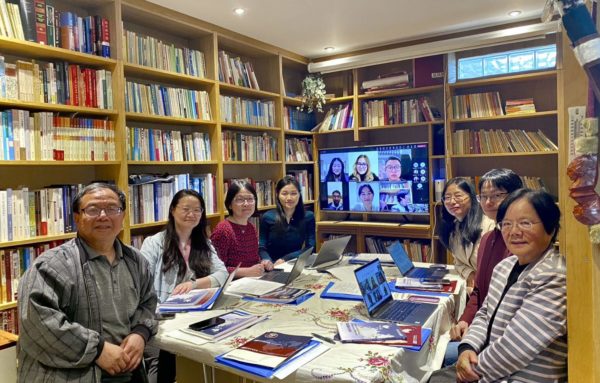
The offline venue was at the Global China Academy Centre. From left to right: Dr. Lianyi Song (SOAS), Dr. Jing Chu (KCL), Dr. Hongfeng Zhou (KCL), Zhonghan Lin (Chair, KCL), Associate Professor Xu Haiyan (Nanchang University, China), Dr. Lijing Shi (LSE), and Professor Xiangqun Chang.

Some presenters. From left to right: Subham Kumar Kanu, CHAN Jack Pui To, Gao Beibei, Agniva Ray, Vibha Ghaty Sreesh, Maria Anna Sampson, Chunjin Li.

Selected presentations. The significant features of this Forum are the global participation including three from India and broader themes compared to the 1st Forum, where the participants were primarily based in London and from SOAS.
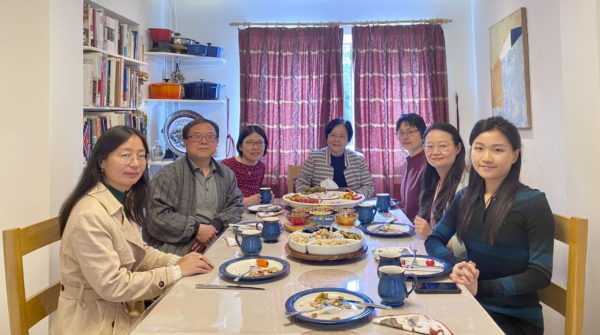
Tea break: Participants enjoyed Zongzi dumplings as June 10th, 2024, closed to the Dragon Boat Festival.
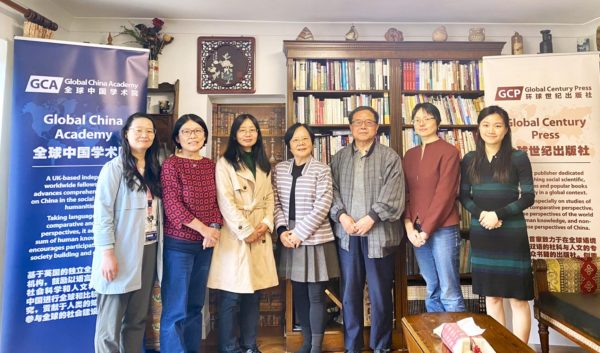
The participants were primarily the Editorial Board members of JCSS. They discussed issues related to the journal.
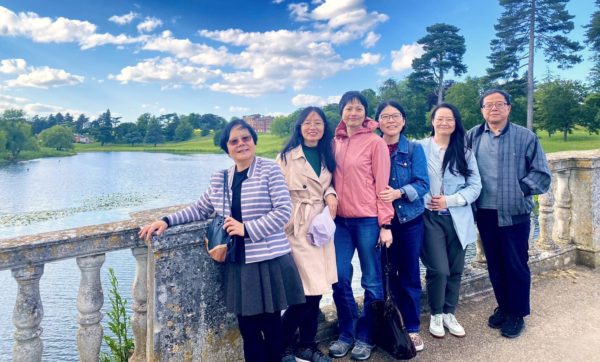
After the forum, participants visited Brocket Hall and enjoyed a walk and dinner there.
Social mission
21st June, Professor Chang Xiangqun, President of the Global China Academy, and Ms YU Li, Project Manager, were invited to attend the 6th Anniversary Champagne Reception and the 20th Anniversary Charity Antique Auction of Mother’s Bridge of Love (MBL) hosted by the Chinese Collectors Club (UK). The event took place at the Whisky Club, 1A Bond Street. After a splendid pipa solo performance by the renowned artist CHENG Yu, the charity auction was hosted by Mr. Zhang Pu, Chairman of the Chinese Collectors Club (UK). All proceeds, amounting to £13,000, were donated to Mother’s Bridge of Love to express gratefulness to the MBL for funding the establishment of 28 children’s libraries in rural and urban areas of China and providing cultural consultations and support for families in 27 countries that have adopted Chinese orphans, helping Chinese orphans.
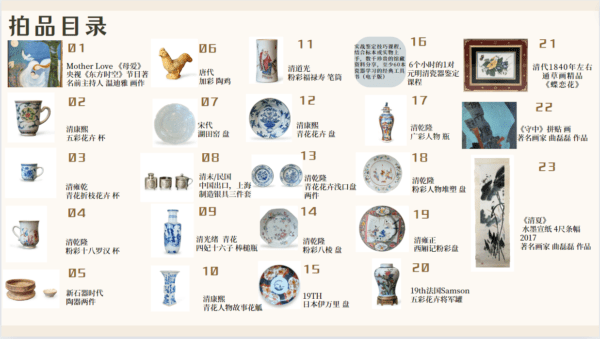
Auction Catalog.
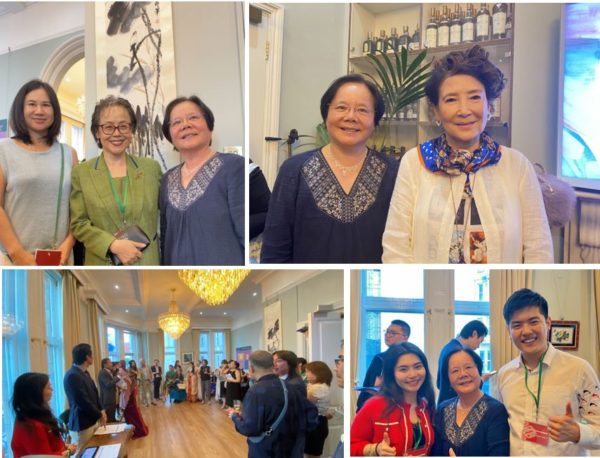
Top left: Xiangqun Chang and Yu Li with Xinran (middle), the founder of MBL. She was one of the panelists at the 1st Global China Dialogue in 2014. Top right: Xiangqun Chang with Jung Chang, author of Wild Swans (1991), Mao: The Unknown Story (2005), and Empress Dowager Cixi (2013). Bottom left: Pu Zhang hosted the auction. Bottom right: Xiangqun Chang met Fellows of The Sociological Review, Dr. William Zhengdong Hu and his wife, who were volunteers there.
On 9th June, with the help of Mr. Kai Liang, Ambassador of Hampton Court Golf Club and Event Officer of GCA, we organized 9 pairs teams to participate in the Mill Hill Mixed Open. Some of them won 1st, 2nd, 4th, 5th, and 6th places, as well as the longest drive. After dinner and prize giving, a Champagne Reception was held at the GCA Centre. The successful event served multiple purposes: mixing Chinese and non-Chinese players, celebrating Tao Liu’s Albatross (three strokes under par on a single hole), and the Chinese Dragon Boat Festival.
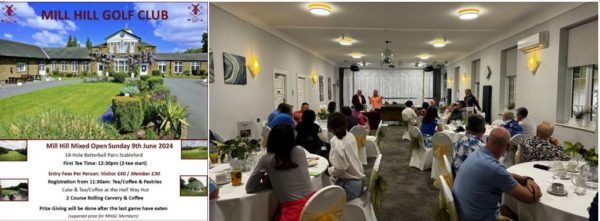
Mill Hill Mixed Open and its dinner and prize giving.
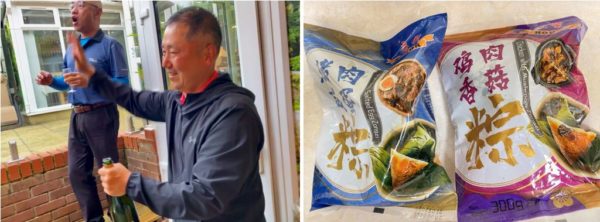
Left: Kai Liang hosted the Champagne Reception and Tao Liu opened a bottle of Champagne. Right: different varieties of Zongzi dumplings.
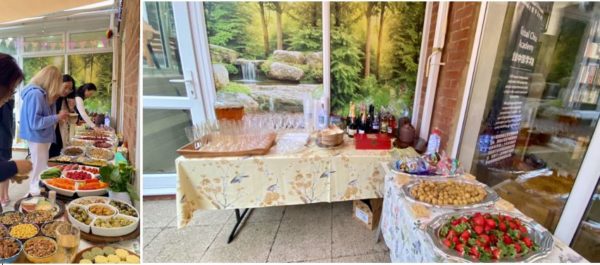
Everyone enjoyed the drinks, soft fruit and snacks.
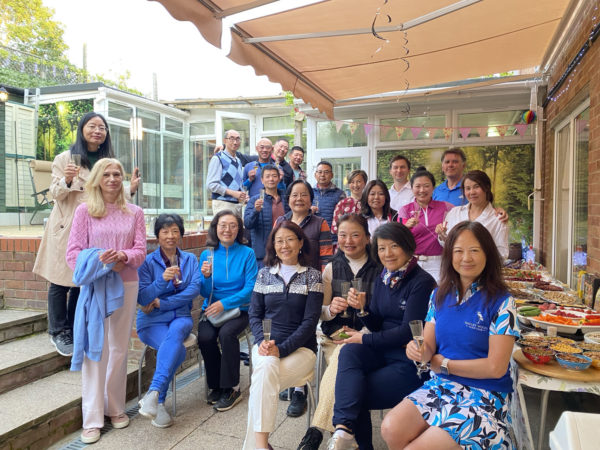
Cheers to Tao Liu and to our gathering!

The event lasted until midnight. It was a wonderful celebration of camaraderie and cultural exchange. We look forward to more successful events in the future, bringing together diverse communities in celebration and fellowship.
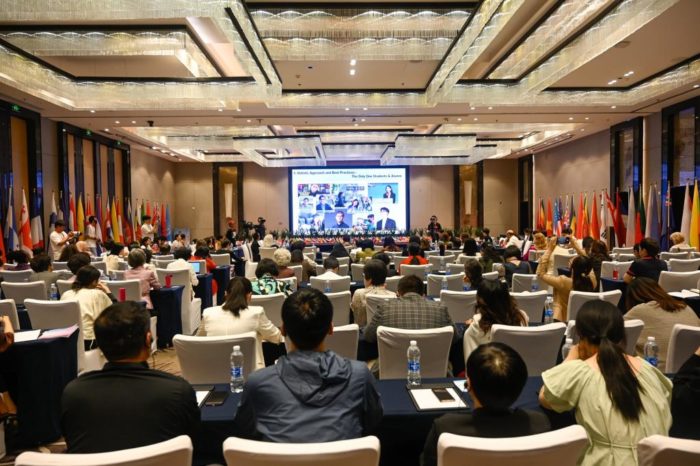
Global China Academy Board of Trustees’s Chair Participates in the 11th WWUPF in Zhengzhou, China, May 25-29, 2024
Maria Jaschok 12 June 2024
On Attending
The 11th World Women University Presidents Forum (WWUPF) 2024,
held in Zhengzhou, Henan, May 25th–29th.
What better way for this new chair of the GCA Board of Trustees to introduce herself, albeit in a rather brief and generally worded presentation, than by means of an academic, which is also a most personal, gendered lens through which I tend to observe, filter, and interpret the complex and divergent realities around me. I have just returned from China where one of my tasks was participation in the 11th World Women University Presidents Forum (WWUPF). An initiative of the Communication University of China (CUC), the WWUPF was launched in August 2001. Its aim is ‘to pool the strength of women university presidents all over the world and to create an international platform for them to communicate and collaborate, and to share new ideas and thoughts in the fields of higher education development and women leadership promotion’ (Brochure, Communications University of China/Huanghe S&T University, 2024).
In addition to ten fora in China, eleven sub-fora have been held around the world. In just over ten years of internationally oriented female-gendered academic discourses, by now with a notable track-record of intellectual and transformative traction, the WWUPF has accumulated considerable credibility. The annual fora clearly benefit from cross/multi-disciplinary and intersectional expertise, and the quality of discourses around significant, topical core themes and critical policy fault lines relevant to gender and Higher Education have garnered close attention from international institutions, as evidenced by the annual participation of representatives from UN agencies and various multilateral organizations.
The 2024 Forum took place in Zhengzhou, Henan, and was dedicated to the theme of ‘Multicultural Backgrounds and Common Development. The Responsibility of Higher Education Leadership.’ Senior UN and UNCESCO leaders sent messages of support which were live-streamed as part of a festive and wide-ranging commencement ceremony which heralded a four-day event of keynote speeches, presentations, and discussions. Artistic performances, exhibitions, and visits to museums and historic sites in Henan rounded off informative cultural excursions, making evident once more the significance of the notion of 中原 zhongyuan culture in relation to the current Chinese government focus on national cultural confidence 文化自信 wenhua zixin.
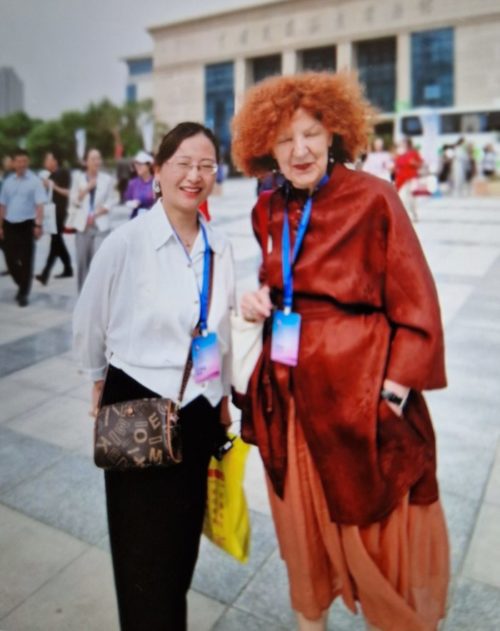
I participated in a panel organized around issues of ‘Openness of Higher Education and Continuity of Civilization’ with a paper on “Studying Elsewhere – cultures of pedagogy, traditions of learning, and fault lines of communication.” The images accompanying this text may help convey the atmosphere of an event that brought together academic, administrative, and political leaders for serious purposes, including many outstanding women leaders of diverse higher education institutions from around the globe. However, most notable was the frequently reiterated pride expressed by Forum participants from such a diversity of national, ethnic, political, and academic backgrounds, a shared pride in having created a meaningful consensus on the importance of an initiative that continues to make a difference despite remarkable global and local challenges.
The transformative powers of female education and its relevance to furthering the SDGs adopted by the UN in 2015 are near-universally shared principles, driving facilitation of enduring institutions for gender justice. Yet such principles are also heavily contested, in certain contexts negated as detrimental to societal development. The WWUPF provides ongoing campaigns for female education at the highest level with solid evidence of the positive impact of capable female leadership in senior positions as it continues to challenge the ongoing underrepresentation of authoritative female voices. The founding initiative for these timely fora, and now their increasingly impactful linkages with international academic institutions and networks, originated from Professor Liu Jinan, then the female president of CUC, making the global mission of the WWUPF all the more remarkable and poignant.
Lastly, but by no means least, for me the most profound and moving experience, both at a personal and autobiographical level, was my return, after an absence of five years, to a part of China with which I had been intensely involved for well over twenty years of research and fieldwork. It was gratifying to have the opportunity once again to listen, interact, learn, observe, and renew contact with old friends and colleagues, whose friendship, knowledge, and incredible generosity are inextricably linked with my understanding of Chinese society.

Photos sources: https://www.hhstu.edu.cn/info/1052/22194.htm, https://news.xmu.edu.cn/info/1003/471011.htm; text provided by the participant.
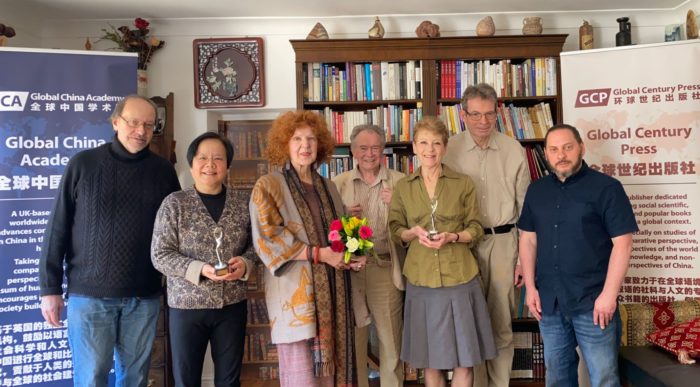
Global China Academy Activities in May 2024
At the GCA Board of Trustees meeting on February 23, 2024, an important agenda item for the Any Other Business (AOB) session was to schedule the Summer meeting for May 9. The session will welcome the new Chair and Secretary, and bid farewell to the outgoing Chair and Secretary.

On May 9, all the Trustees participated in the hybrid meeting. From left to right: Xiangqun Chang, Mark Lee (who joined the meeting after being elected Trustee and Secretary), Grace Yuan Cheng (online), Thomas Clarke, Maria Jaschok (new Chair), and Charles Grant.

Top left and right: Professor Maria Jaschok, representing the Trustees, thanked the former Chair, Ingrid Cranfield, and presented her with an ‘Oscar’ as a token of their appreciation for her work with GCA and GCP. The former Secretary, Dr. Francis Wood, was unable to attend due to illness. Professor Xiangqun Chang received the ‘Oscar’ on her behalf and will present it to her in due course.
Bottom photos on the left and right: Professor Martin Albrow, the Founding and Honorary President of GCA, presented flowers to Professor Maria Jaschok, the new Chair of the Board of Trustees, and welcomed Mark Lee to support GCA. The photo in the middle signifies the GCA’s Board of Trustees continuing the past and forging ahead.
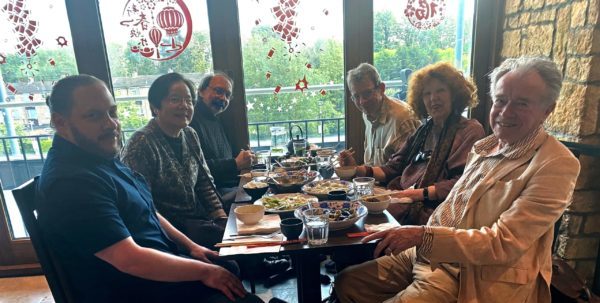
After the meeting, some participants of the GCA Board meeting decided to experience the newly developed GCA’s Route 6 of the Six ‘walk and talk’ routes, which included tea and lunch. The above photo shows them having lunch at the Real China Restaurant at the Galleria Outlet Shopping Centre in Hatfield.
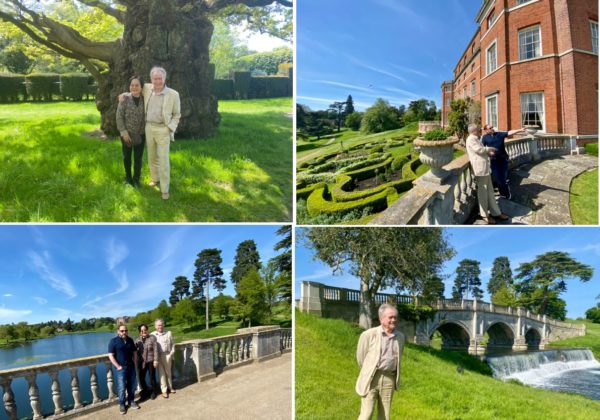
Professor Martin Albrow, Professor Xiangqun Chang, and Mark Lee enjoyed their walk and talk at Brocket Hall very much after the lunch.

On the following day, Professor Xiangqun Chang visited Ingrid Cranfield’s home. She enjoyed Ingrid’s homemade cake, summer fruit, and relaxed conversation, especially the observations of her pet peahen and chicken. Although pigeons typically symbolize peace, the harmonious coexistence of these pets could also represent hope for humanity.
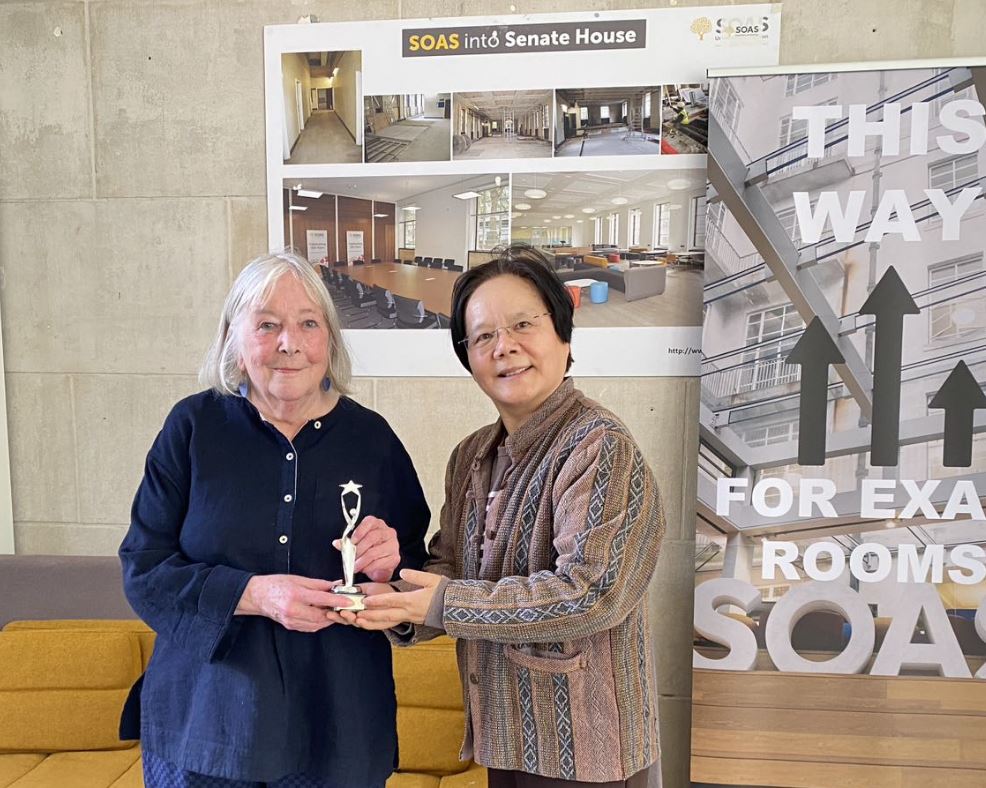
On the occasion of participating in a public lecture entitled ‘The Construction and Development of Digital Dunhuang’ on the 29th of May at SOAS, Professor Xiangqun Chang had a meeting with Dr Frances Wood. She greatly appreciated Dr Wood’s continued support for GCA and GCP with her academic and professional expertise in her personal capacity in the future. Professor Chang expressed gratitude for Dr Wood’s contributions to GCA and GCP in the past years and presented her with an ‘Oscar’ on behalf of the Chair of the Board of Trustees.
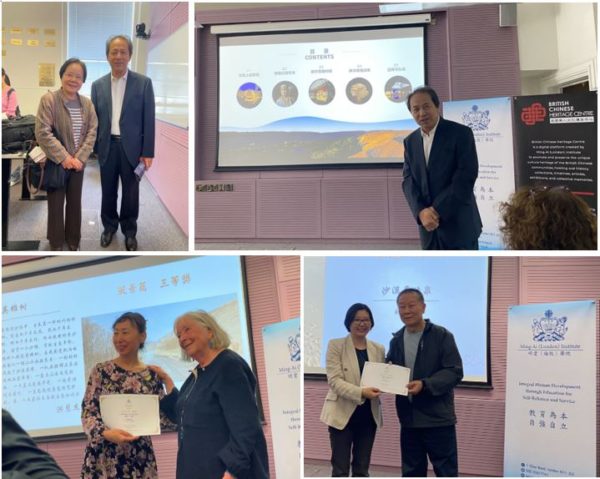
Top left: Professor Xiangqun Chang with WU Jian, Professorial Research Fellow of the Dunhuang Institute, the speaker of ‘The Construction and Development of Digital Dunhuang.’ They discussed the possibilities of a collaborative publication project on the theme of transculturality based on a vast amount of digital materials.
Top right: Professor Wu Jian gave a public lecture. According to him, Dunhuang was an important cultural node on the ancient Silk Road in China, witnessing the exchange and integration of Eastern and Western cultures. After more than 30 years of exploration and research, Digital Dunhuang formed a complete technological process suitable for the digital collection, processing, and storage of immovable cultural relics, and methods for constructing Digital Dunhuang, showcasing massive digital achievements and application scenarios of Digital Dunhuang. This lecture focused on the artistic value inheritance of the Dunhuang Grottoes, aiming at the digital preservation of cultural heritage for its sustainable inheritance. It started from the significance of advanced digital technology empowering cultural heritage protection and inheritance and discussed the development, achievements, and innovations in the three important stages of digital protection of Dunhuang Grottoes.
Following the public lecture, there was the Digital Photography Exhibition ‘Dream Back to Dunhuang.’ The bottom photos show Dr. Frances Wood (left) and Mr. Qu Leilei (right), the UK-based artist, presenting certificates to the winners of the Digital Photography Exhibition.
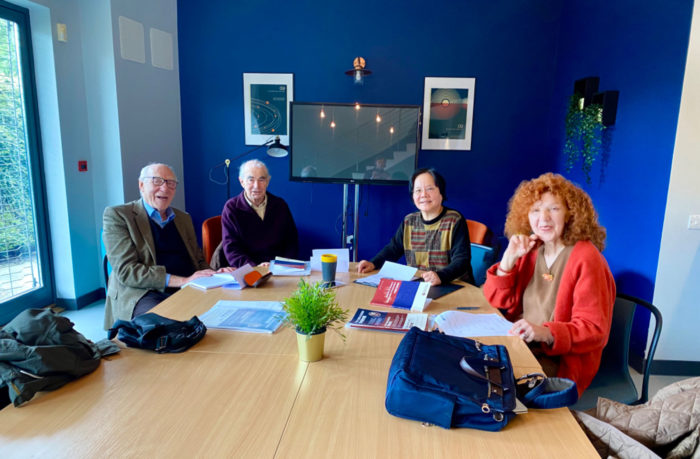
Global China Academy’s Activities in April 2024
On April 17, Professor Xiangqun Chang visited GCA Fellows at the University Club at Oxford. The fellows are Professor David Parkin, Professor Robin Cohen, and Professor Maria Jaschok. In the morning, they conducted a broad range of discussions. During lunchtime, in addition to discussing work, Professor David Parkin suggested that we should also add a little living to our life. In the afternoon, Xiangqun and Maria discussed detailed work on the GCA Board of Trustees. It was a very productive day.

From left to right: Robin Cohen, David Parkin, Xiangqun Chang, and Maria Jaschok. The discussion meeting was similar to a brainstorming session. Based on incomplete audio records, the following topics were covered:
- Transculturality:
- Definition and examples of transcultural practices.
- The concept of transculturality as a tool for understanding global dynamics beyond globalization.
- Comparison between Chinese and Western approaches to transculturality.
2. Reciprocity and Social Exchange:
- Different types of reciprocity: generalized, balanced, and negative exchange.
- The role of reciprocity in social relationships and its implications in different cultural contexts.
3. Academic Contributions and Challenges:
- The need for a Chinese school of sociology and its contributions to global social science.
- The challenges faced by Chinese academics in the global academic landscape.
- Strategies for integrating Chinese perspectives into global academic discussions.
4. Social Practices and Their Cultural Significance:
- The influence of Chinese cultural practices on social relationships and community building.
- Examples of social practices in Chinese villages and their implications for social structure.
5. Historical and Comparative Studies:
- Comparative studies on modernization in different countries.
Historical encounters between Europe and China and their impact on cultural exchange. - The role of Chinese academics in documenting and analyzing these historical interactions.
6. Globalization and Modernization:
- The evolution of globalization and its various forms.
The concept of modernization in China and its comparison with Western perspectives. - The impact of globalization on local cultures and practices.
7. Role of Chinese Women and Feminism:
- The development of Chinese feminism and its integration into global feminist discourse.
- Historical perspectives on Chinese women’s roles and contributions.
8. Networking and Collaboration:
- The importance of collaborating with similar institutions to sustain the mission of the Global China Academy.
- Potential partnerships with organizations like the United Nations Alliance of Civilizations (UNAOC).
9. Impact and Sustainability of the Global China Academy:
- Strategies for ensuring the sustainability of the academy.
The role of publications and academic dialogues in promoting the academy’s mission. - The importance of engaging younger generations in the academy’s work.
10. Fieldwork and Ethnographic Studies:
- Personal anecdotes and experiences from fieldwork in China.
- The significance of understanding local contexts and social dynamics through ethnographic research.
11. Political and Cultural Mapping:
- The role of maps in representing cultural and political relationships.
- The influence of mapping practices on understanding global connections and power dynamics.
12. Challenges of Publishing Uncensored Chinese Work:
- The difficulties in publishing authentic, uncensored academic work on China.
- The role of the Global China Academy in providing a platform for such publications.
13. Global Governance for AI:
- This is the theme of the 9th Global China Dialogue, which will take place at Tongji University in China. It is the first time the event will be held in China, and it will alternate between the UK and China in the future.
- The preparations are ongoing.
On April 27, the GCA team met for a one-day occasion. In the morning, some of us played golf at Hill Hill Golf Club. During the lunch meeting, it was agreed that Mr. Kai Liang would join us as Event Officer of GCA and Ms YU Li as Project Manager. In the afternoon, the team went to Brocket Hall for a walk and had dinner at the Real China Restaurant at the Galleria Outlet Shopping Centre in Hatfield. Thus, the sixth ‘walk and talk’ route was developed.

Participants in the day’s activities in the top photo from left to right: Kai Liang (Event Officer), Katie Zheng (Administrative Manager), Alan Fang (Legal Adviser), Yu Li (Project Manager), David Liu (Logistics Manager), and Xiangqun Chang (President).

